Developing Corporate Culture
VerifiedAdded on 2022/12/28
|18
|6090
|184
AI Summary
This document discusses the importance of developing corporate culture in an organization and its impact on achieving objectives. It explores models of organization culture, the difference between organizational and national culture, analyzes the corporate cultural profile in two chosen organizations, and discusses the impact of corporate culture on achieving objectives. It also evaluates the existing climate of an organization and recommends ways to improve corporate climate. Additionally, it proposes a framework of organizational values and strategies for effective communication with stakeholders.
Contribute Materials
Your contribution can guide someone’s learning journey. Share your
documents today.
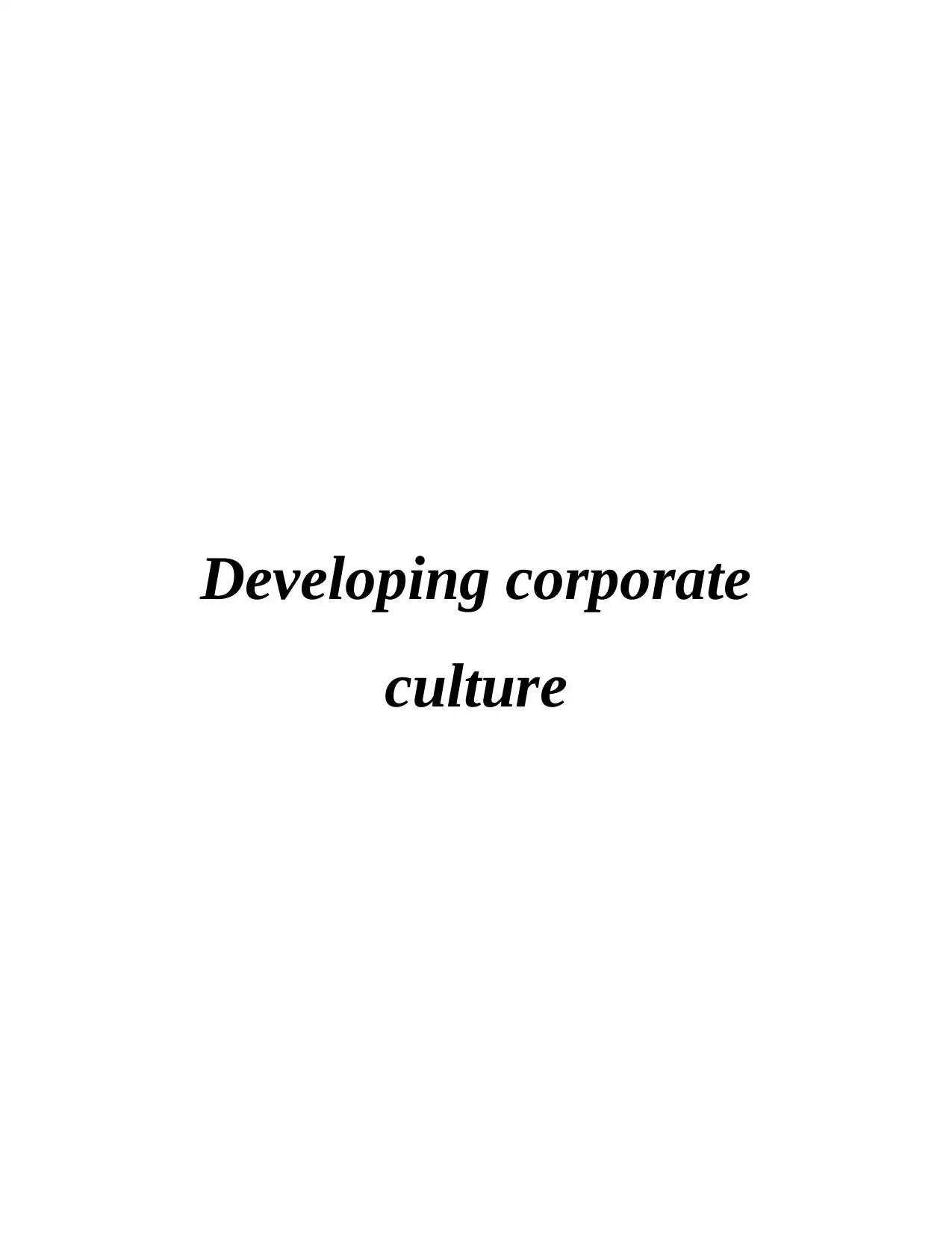
Developing corporate
culture
culture
Secure Best Marks with AI Grader
Need help grading? Try our AI Grader for instant feedback on your assignments.
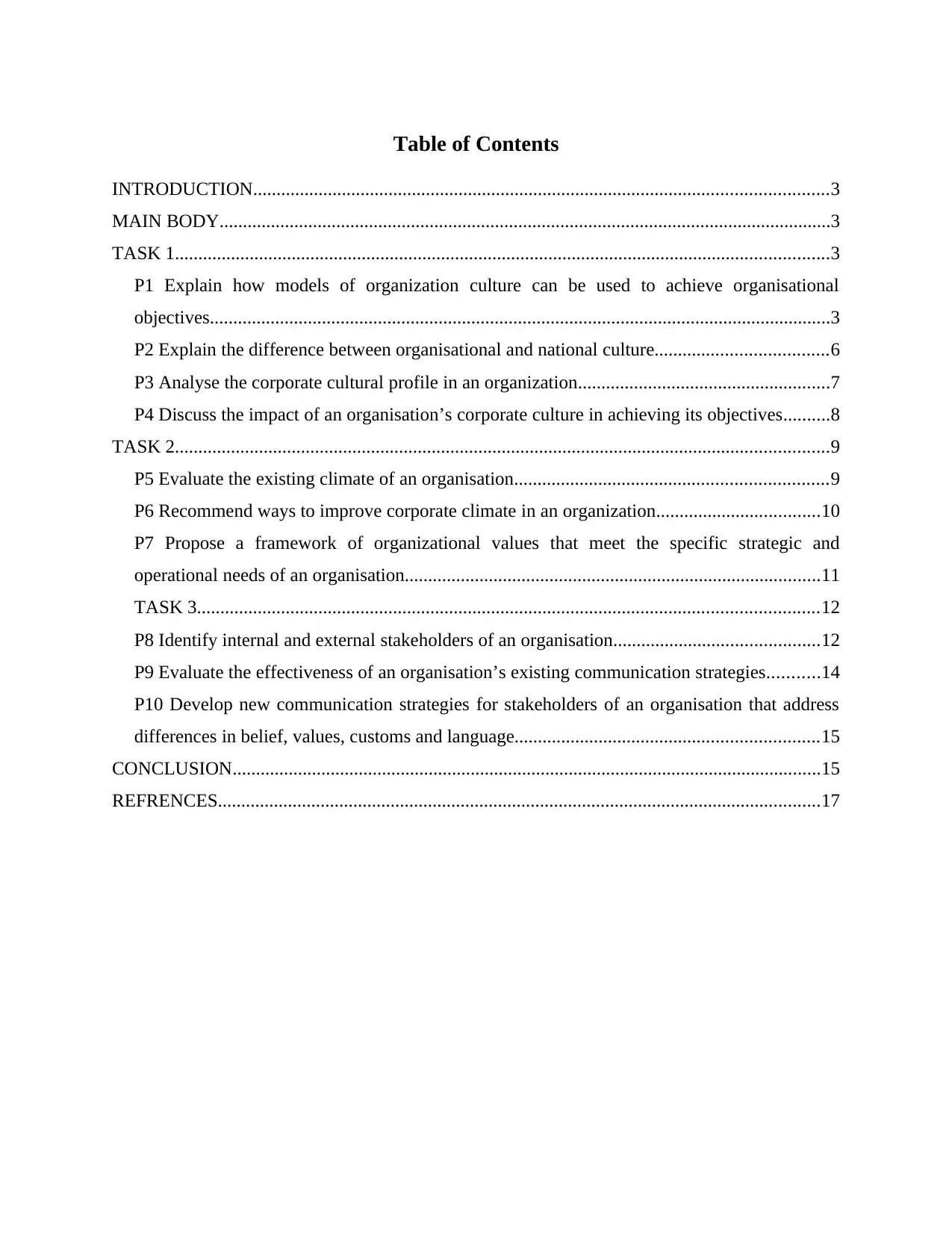
Table of Contents
INTRODUCTION...........................................................................................................................3
MAIN BODY...................................................................................................................................3
TASK 1............................................................................................................................................3
P1 Explain how models of organization culture can be used to achieve organisational
objectives.....................................................................................................................................3
P2 Explain the difference between organisational and national culture.....................................6
P3 Analyse the corporate cultural profile in an organization......................................................7
P4 Discuss the impact of an organisation’s corporate culture in achieving its objectives..........8
TASK 2............................................................................................................................................9
P5 Evaluate the existing climate of an organisation...................................................................9
P6 Recommend ways to improve corporate climate in an organization...................................10
P7 Propose a framework of organizational values that meet the specific strategic and
operational needs of an organisation.........................................................................................11
TASK 3.....................................................................................................................................12
P8 Identify internal and external stakeholders of an organisation............................................12
P9 Evaluate the effectiveness of an organisation’s existing communication strategies...........14
P10 Develop new communication strategies for stakeholders of an organisation that address
differences in belief, values, customs and language.................................................................15
CONCLUSION..............................................................................................................................15
REFRENCES.................................................................................................................................17
INTRODUCTION...........................................................................................................................3
MAIN BODY...................................................................................................................................3
TASK 1............................................................................................................................................3
P1 Explain how models of organization culture can be used to achieve organisational
objectives.....................................................................................................................................3
P2 Explain the difference between organisational and national culture.....................................6
P3 Analyse the corporate cultural profile in an organization......................................................7
P4 Discuss the impact of an organisation’s corporate culture in achieving its objectives..........8
TASK 2............................................................................................................................................9
P5 Evaluate the existing climate of an organisation...................................................................9
P6 Recommend ways to improve corporate climate in an organization...................................10
P7 Propose a framework of organizational values that meet the specific strategic and
operational needs of an organisation.........................................................................................11
TASK 3.....................................................................................................................................12
P8 Identify internal and external stakeholders of an organisation............................................12
P9 Evaluate the effectiveness of an organisation’s existing communication strategies...........14
P10 Develop new communication strategies for stakeholders of an organisation that address
differences in belief, values, customs and language.................................................................15
CONCLUSION..............................................................................................................................15
REFRENCES.................................................................................................................................17
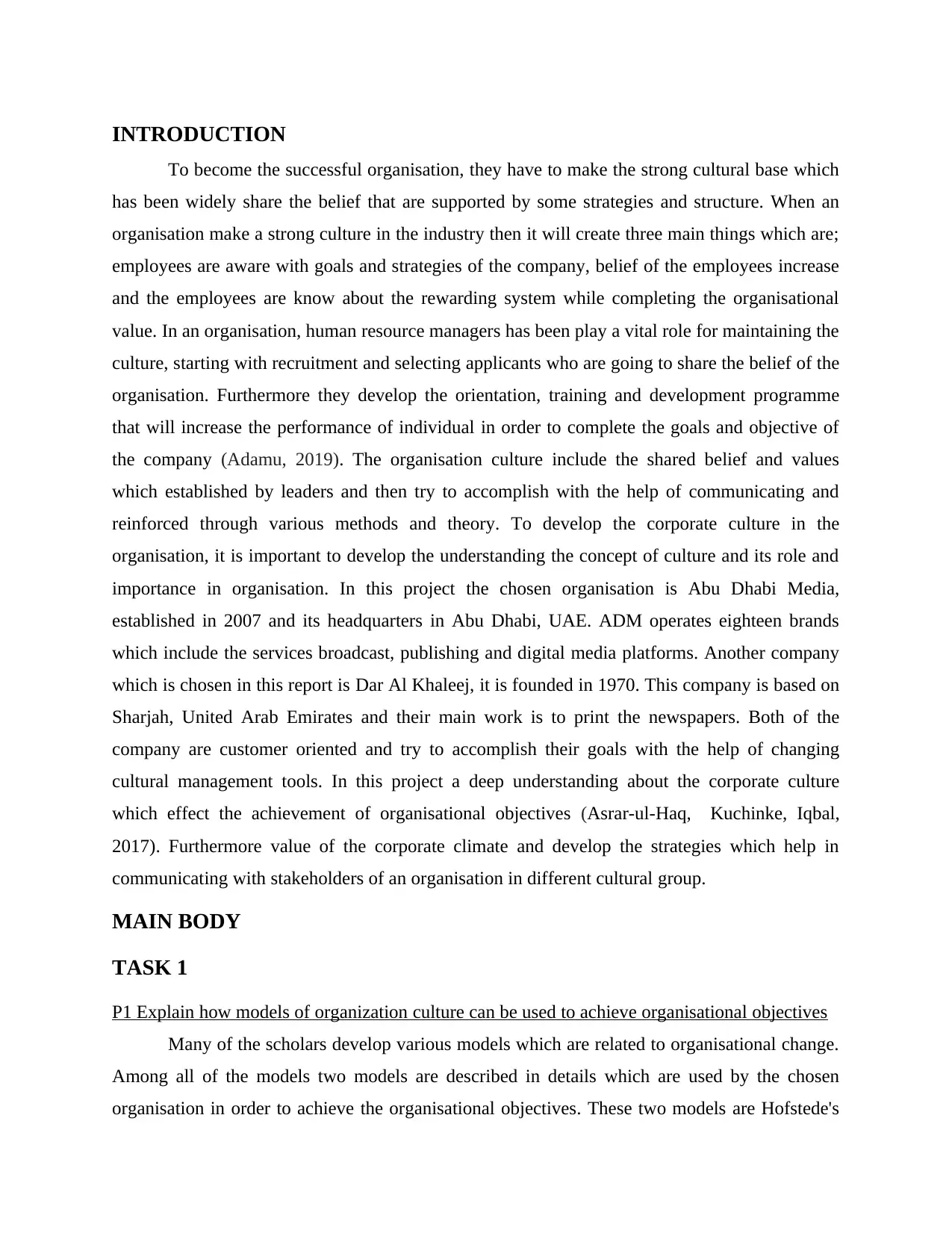
INTRODUCTION
To become the successful organisation, they have to make the strong cultural base which
has been widely share the belief that are supported by some strategies and structure. When an
organisation make a strong culture in the industry then it will create three main things which are;
employees are aware with goals and strategies of the company, belief of the employees increase
and the employees are know about the rewarding system while completing the organisational
value. In an organisation, human resource managers has been play a vital role for maintaining the
culture, starting with recruitment and selecting applicants who are going to share the belief of the
organisation. Furthermore they develop the orientation, training and development programme
that will increase the performance of individual in order to complete the goals and objective of
the company (Adamu, 2019). The organisation culture include the shared belief and values
which established by leaders and then try to accomplish with the help of communicating and
reinforced through various methods and theory. To develop the corporate culture in the
organisation, it is important to develop the understanding the concept of culture and its role and
importance in organisation. In this project the chosen organisation is Abu Dhabi Media,
established in 2007 and its headquarters in Abu Dhabi, UAE. ADM operates eighteen brands
which include the services broadcast, publishing and digital media platforms. Another company
which is chosen in this report is Dar Al Khaleej, it is founded in 1970. This company is based on
Sharjah, United Arab Emirates and their main work is to print the newspapers. Both of the
company are customer oriented and try to accomplish their goals with the help of changing
cultural management tools. In this project a deep understanding about the corporate culture
which effect the achievement of organisational objectives (Asrar-ul-Haq, Kuchinke, Iqbal,
2017). Furthermore value of the corporate climate and develop the strategies which help in
communicating with stakeholders of an organisation in different cultural group.
MAIN BODY
TASK 1
P1 Explain how models of organization culture can be used to achieve organisational objectives
Many of the scholars develop various models which are related to organisational change.
Among all of the models two models are described in details which are used by the chosen
organisation in order to achieve the organisational objectives. These two models are Hofstede's
To become the successful organisation, they have to make the strong cultural base which
has been widely share the belief that are supported by some strategies and structure. When an
organisation make a strong culture in the industry then it will create three main things which are;
employees are aware with goals and strategies of the company, belief of the employees increase
and the employees are know about the rewarding system while completing the organisational
value. In an organisation, human resource managers has been play a vital role for maintaining the
culture, starting with recruitment and selecting applicants who are going to share the belief of the
organisation. Furthermore they develop the orientation, training and development programme
that will increase the performance of individual in order to complete the goals and objective of
the company (Adamu, 2019). The organisation culture include the shared belief and values
which established by leaders and then try to accomplish with the help of communicating and
reinforced through various methods and theory. To develop the corporate culture in the
organisation, it is important to develop the understanding the concept of culture and its role and
importance in organisation. In this project the chosen organisation is Abu Dhabi Media,
established in 2007 and its headquarters in Abu Dhabi, UAE. ADM operates eighteen brands
which include the services broadcast, publishing and digital media platforms. Another company
which is chosen in this report is Dar Al Khaleej, it is founded in 1970. This company is based on
Sharjah, United Arab Emirates and their main work is to print the newspapers. Both of the
company are customer oriented and try to accomplish their goals with the help of changing
cultural management tools. In this project a deep understanding about the corporate culture
which effect the achievement of organisational objectives (Asrar-ul-Haq, Kuchinke, Iqbal,
2017). Furthermore value of the corporate climate and develop the strategies which help in
communicating with stakeholders of an organisation in different cultural group.
MAIN BODY
TASK 1
P1 Explain how models of organization culture can be used to achieve organisational objectives
Many of the scholars develop various models which are related to organisational change.
Among all of the models two models are described in details which are used by the chosen
organisation in order to achieve the organisational objectives. These two models are Hofstede's
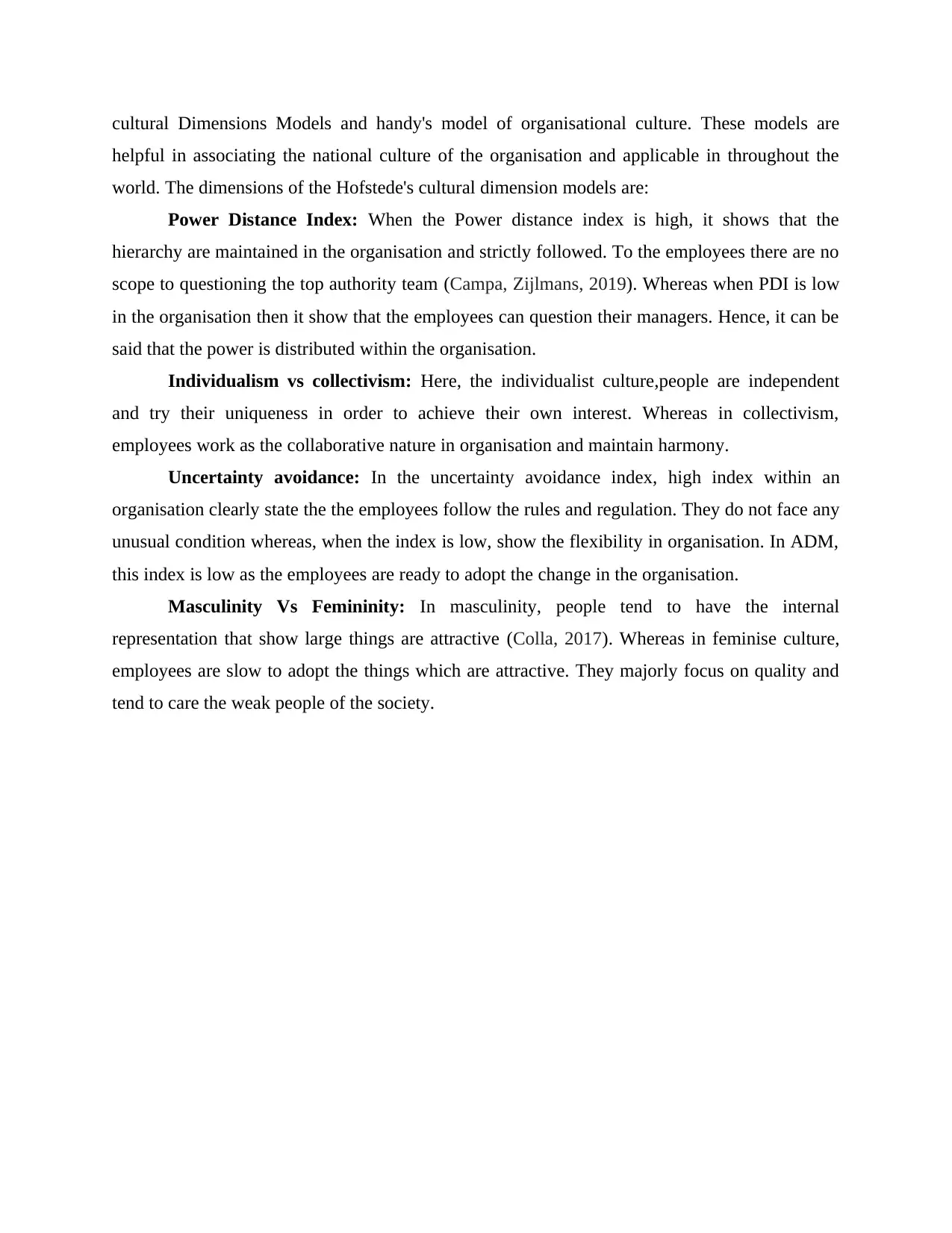
cultural Dimensions Models and handy's model of organisational culture. These models are
helpful in associating the national culture of the organisation and applicable in throughout the
world. The dimensions of the Hofstede's cultural dimension models are:
Power Distance Index: When the Power distance index is high, it shows that the
hierarchy are maintained in the organisation and strictly followed. To the employees there are no
scope to questioning the top authority team (Campa, Zijlmans, 2019). Whereas when PDI is low
in the organisation then it show that the employees can question their managers. Hence, it can be
said that the power is distributed within the organisation.
Individualism vs collectivism: Here, the individualist culture,people are independent
and try their uniqueness in order to achieve their own interest. Whereas in collectivism,
employees work as the collaborative nature in organisation and maintain harmony.
Uncertainty avoidance: In the uncertainty avoidance index, high index within an
organisation clearly state the the employees follow the rules and regulation. They do not face any
unusual condition whereas, when the index is low, show the flexibility in organisation. In ADM,
this index is low as the employees are ready to adopt the change in the organisation.
Masculinity Vs Femininity: In masculinity, people tend to have the internal
representation that show large things are attractive (Colla, 2017). Whereas in feminise culture,
employees are slow to adopt the things which are attractive. They majorly focus on quality and
tend to care the weak people of the society.
helpful in associating the national culture of the organisation and applicable in throughout the
world. The dimensions of the Hofstede's cultural dimension models are:
Power Distance Index: When the Power distance index is high, it shows that the
hierarchy are maintained in the organisation and strictly followed. To the employees there are no
scope to questioning the top authority team (Campa, Zijlmans, 2019). Whereas when PDI is low
in the organisation then it show that the employees can question their managers. Hence, it can be
said that the power is distributed within the organisation.
Individualism vs collectivism: Here, the individualist culture,people are independent
and try their uniqueness in order to achieve their own interest. Whereas in collectivism,
employees work as the collaborative nature in organisation and maintain harmony.
Uncertainty avoidance: In the uncertainty avoidance index, high index within an
organisation clearly state the the employees follow the rules and regulation. They do not face any
unusual condition whereas, when the index is low, show the flexibility in organisation. In ADM,
this index is low as the employees are ready to adopt the change in the organisation.
Masculinity Vs Femininity: In masculinity, people tend to have the internal
representation that show large things are attractive (Colla, 2017). Whereas in feminise culture,
employees are slow to adopt the things which are attractive. They majorly focus on quality and
tend to care the weak people of the society.
Secure Best Marks with AI Grader
Need help grading? Try our AI Grader for instant feedback on your assignments.
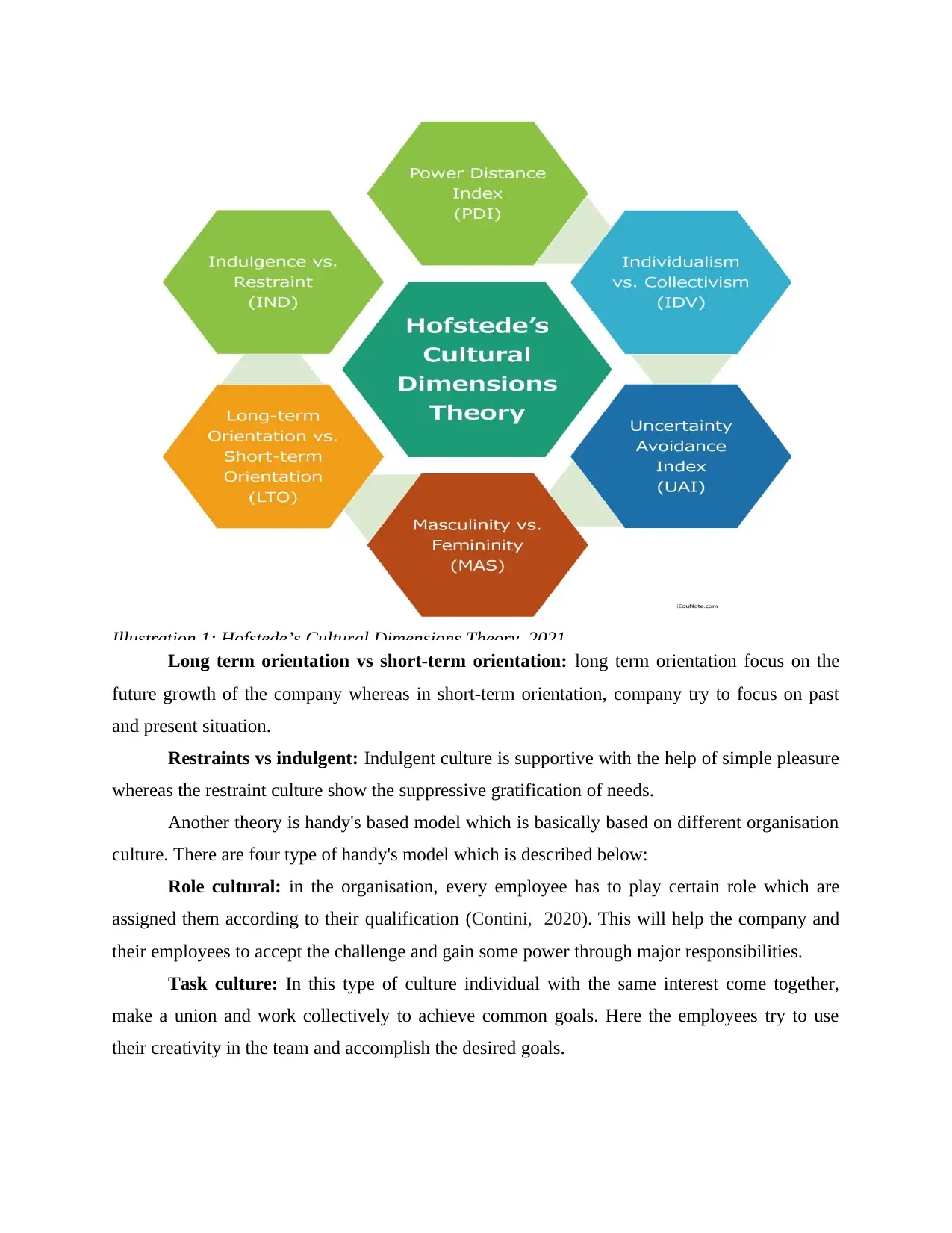
Long term orientation vs short-term orientation: long term orientation focus on the
future growth of the company whereas in short-term orientation, company try to focus on past
and present situation.
Restraints vs indulgent: Indulgent culture is supportive with the help of simple pleasure
whereas the restraint culture show the suppressive gratification of needs.
Another theory is handy's based model which is basically based on different organisation
culture. There are four type of handy's model which is described below:
Role cultural: in the organisation, every employee has to play certain role which are
assigned them according to their qualification (Contini, 2020). This will help the company and
their employees to accept the challenge and gain some power through major responsibilities.
Task culture: In this type of culture individual with the same interest come together,
make a union and work collectively to achieve common goals. Here the employees try to use
their creativity in the team and accomplish the desired goals.
Illustration 1: Hofstede’s Cultural Dimensions Theory, 2021.
future growth of the company whereas in short-term orientation, company try to focus on past
and present situation.
Restraints vs indulgent: Indulgent culture is supportive with the help of simple pleasure
whereas the restraint culture show the suppressive gratification of needs.
Another theory is handy's based model which is basically based on different organisation
culture. There are four type of handy's model which is described below:
Role cultural: in the organisation, every employee has to play certain role which are
assigned them according to their qualification (Contini, 2020). This will help the company and
their employees to accept the challenge and gain some power through major responsibilities.
Task culture: In this type of culture individual with the same interest come together,
make a union and work collectively to achieve common goals. Here the employees try to use
their creativity in the team and accomplish the desired goals.
Illustration 1: Hofstede’s Cultural Dimensions Theory, 2021.
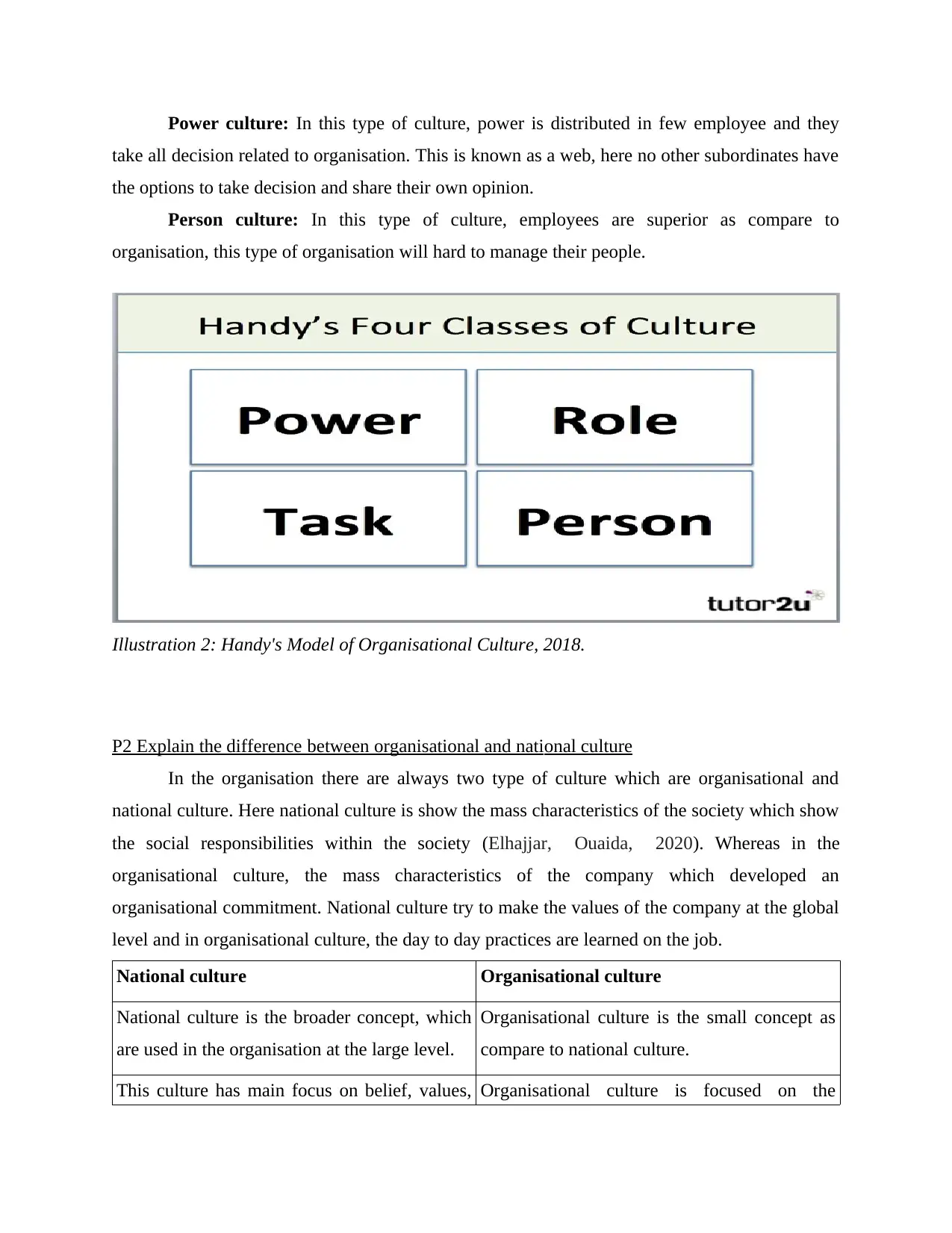
Power culture: In this type of culture, power is distributed in few employee and they
take all decision related to organisation. This is known as a web, here no other subordinates have
the options to take decision and share their own opinion.
Person culture: In this type of culture, employees are superior as compare to
organisation, this type of organisation will hard to manage their people.
P2 Explain the difference between organisational and national culture
In the organisation there are always two type of culture which are organisational and
national culture. Here national culture is show the mass characteristics of the society which show
the social responsibilities within the society (Elhajjar, Ouaida, 2020). Whereas in the
organisational culture, the mass characteristics of the company which developed an
organisational commitment. National culture try to make the values of the company at the global
level and in organisational culture, the day to day practices are learned on the job.
National culture Organisational culture
National culture is the broader concept, which
are used in the organisation at the large level.
Organisational culture is the small concept as
compare to national culture.
This culture has main focus on belief, values, Organisational culture is focused on the
Illustration 2: Handy's Model of Organisational Culture, 2018.
take all decision related to organisation. This is known as a web, here no other subordinates have
the options to take decision and share their own opinion.
Person culture: In this type of culture, employees are superior as compare to
organisation, this type of organisation will hard to manage their people.
P2 Explain the difference between organisational and national culture
In the organisation there are always two type of culture which are organisational and
national culture. Here national culture is show the mass characteristics of the society which show
the social responsibilities within the society (Elhajjar, Ouaida, 2020). Whereas in the
organisational culture, the mass characteristics of the company which developed an
organisational commitment. National culture try to make the values of the company at the global
level and in organisational culture, the day to day practices are learned on the job.
National culture Organisational culture
National culture is the broader concept, which
are used in the organisation at the large level.
Organisational culture is the small concept as
compare to national culture.
This culture has main focus on belief, values, Organisational culture is focused on the
Illustration 2: Handy's Model of Organisational Culture, 2018.
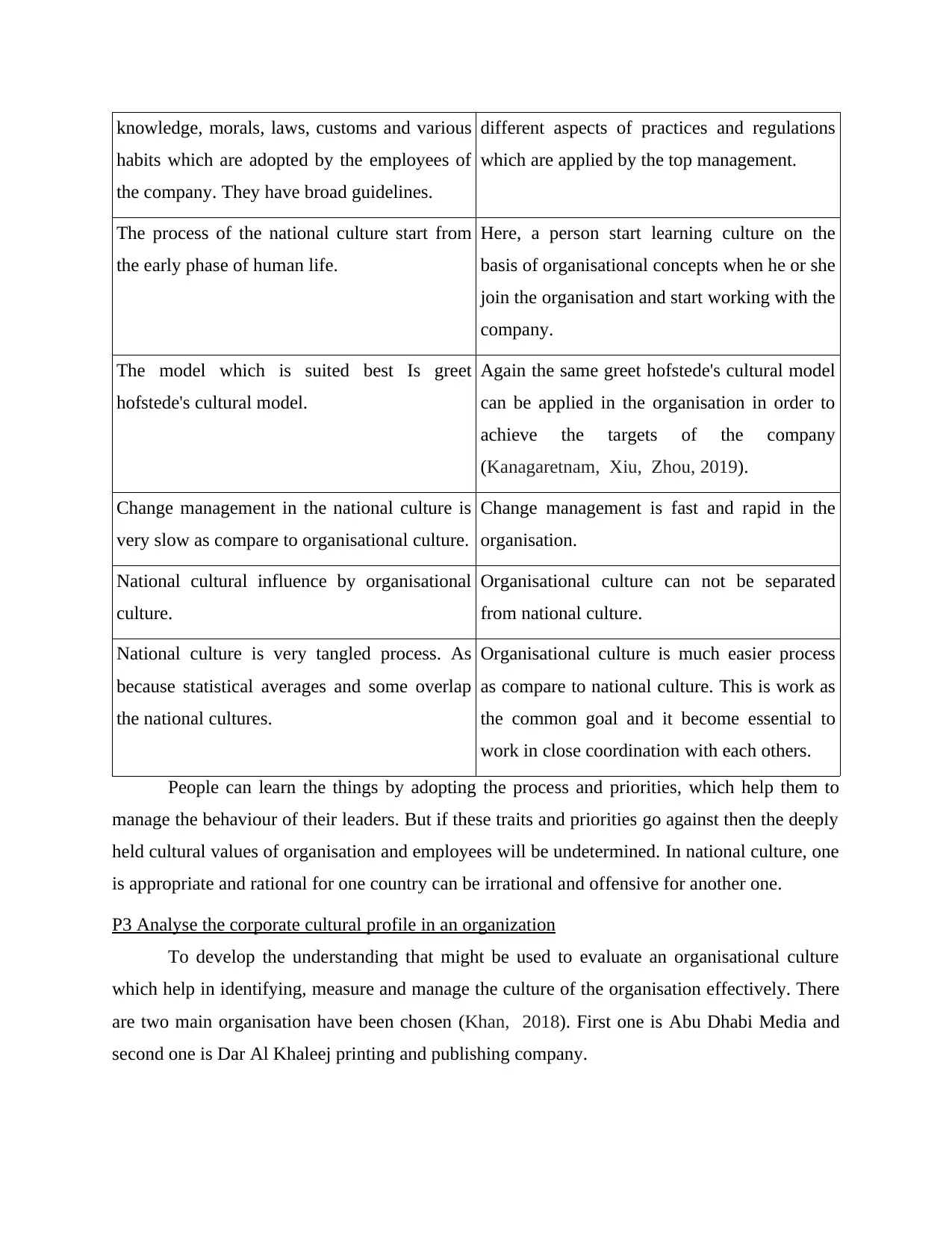
knowledge, morals, laws, customs and various
habits which are adopted by the employees of
the company. They have broad guidelines.
different aspects of practices and regulations
which are applied by the top management.
The process of the national culture start from
the early phase of human life.
Here, a person start learning culture on the
basis of organisational concepts when he or she
join the organisation and start working with the
company.
The model which is suited best Is greet
hofstede's cultural model.
Again the same greet hofstede's cultural model
can be applied in the organisation in order to
achieve the targets of the company
(Kanagaretnam, Xiu, Zhou, 2019).
Change management in the national culture is
very slow as compare to organisational culture.
Change management is fast and rapid in the
organisation.
National cultural influence by organisational
culture.
Organisational culture can not be separated
from national culture.
National culture is very tangled process. As
because statistical averages and some overlap
the national cultures.
Organisational culture is much easier process
as compare to national culture. This is work as
the common goal and it become essential to
work in close coordination with each others.
People can learn the things by adopting the process and priorities, which help them to
manage the behaviour of their leaders. But if these traits and priorities go against then the deeply
held cultural values of organisation and employees will be undetermined. In national culture, one
is appropriate and rational for one country can be irrational and offensive for another one.
P3 Analyse the corporate cultural profile in an organization
To develop the understanding that might be used to evaluate an organisational culture
which help in identifying, measure and manage the culture of the organisation effectively. There
are two main organisation have been chosen (Khan, 2018). First one is Abu Dhabi Media and
second one is Dar Al Khaleej printing and publishing company.
habits which are adopted by the employees of
the company. They have broad guidelines.
different aspects of practices and regulations
which are applied by the top management.
The process of the national culture start from
the early phase of human life.
Here, a person start learning culture on the
basis of organisational concepts when he or she
join the organisation and start working with the
company.
The model which is suited best Is greet
hofstede's cultural model.
Again the same greet hofstede's cultural model
can be applied in the organisation in order to
achieve the targets of the company
(Kanagaretnam, Xiu, Zhou, 2019).
Change management in the national culture is
very slow as compare to organisational culture.
Change management is fast and rapid in the
organisation.
National cultural influence by organisational
culture.
Organisational culture can not be separated
from national culture.
National culture is very tangled process. As
because statistical averages and some overlap
the national cultures.
Organisational culture is much easier process
as compare to national culture. This is work as
the common goal and it become essential to
work in close coordination with each others.
People can learn the things by adopting the process and priorities, which help them to
manage the behaviour of their leaders. But if these traits and priorities go against then the deeply
held cultural values of organisation and employees will be undetermined. In national culture, one
is appropriate and rational for one country can be irrational and offensive for another one.
P3 Analyse the corporate cultural profile in an organization
To develop the understanding that might be used to evaluate an organisational culture
which help in identifying, measure and manage the culture of the organisation effectively. There
are two main organisation have been chosen (Khan, 2018). First one is Abu Dhabi Media and
second one is Dar Al Khaleej printing and publishing company.
Paraphrase This Document
Need a fresh take? Get an instant paraphrase of this document with our AI Paraphraser
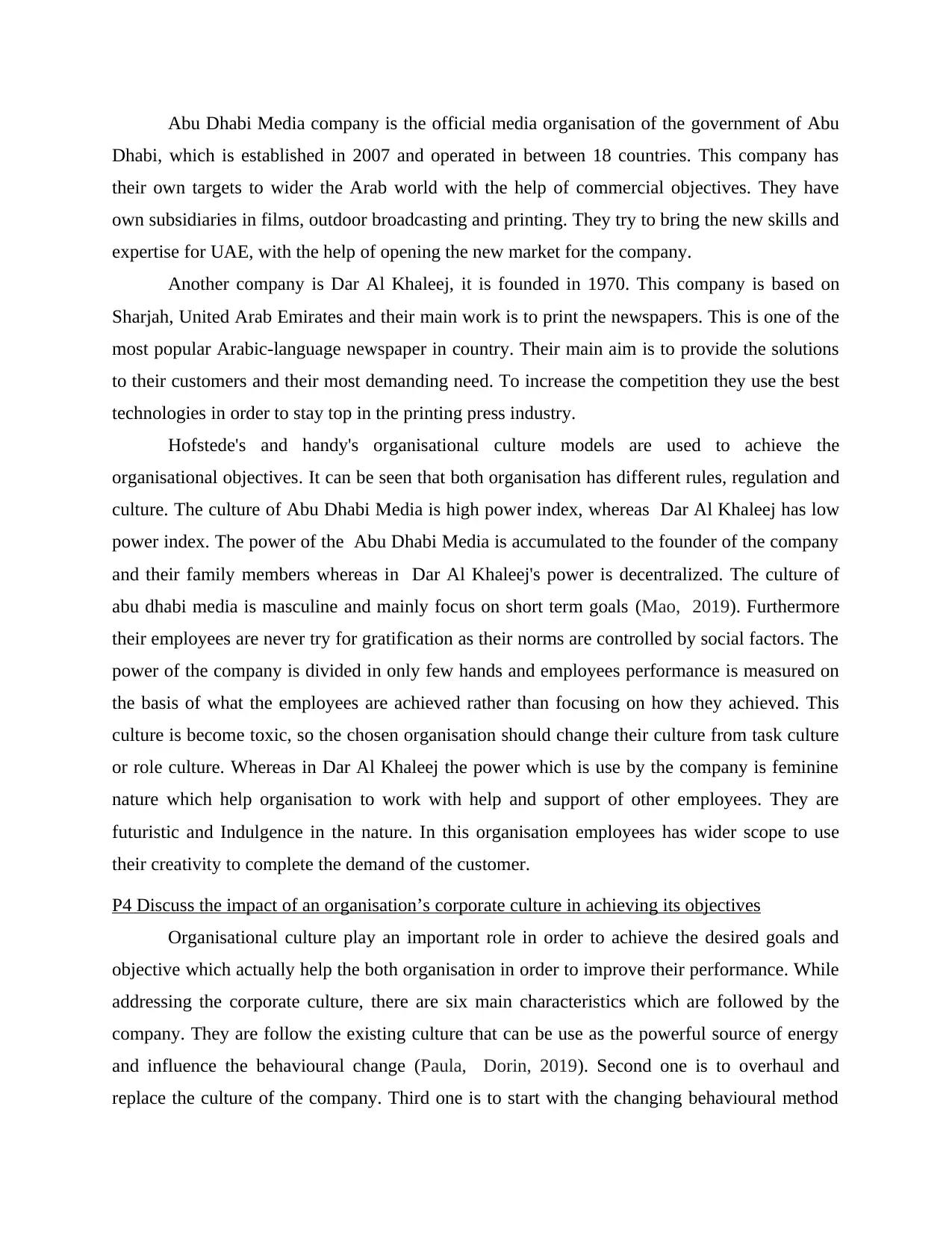
Abu Dhabi Media company is the official media organisation of the government of Abu
Dhabi, which is established in 2007 and operated in between 18 countries. This company has
their own targets to wider the Arab world with the help of commercial objectives. They have
own subsidiaries in films, outdoor broadcasting and printing. They try to bring the new skills and
expertise for UAE, with the help of opening the new market for the company.
Another company is Dar Al Khaleej, it is founded in 1970. This company is based on
Sharjah, United Arab Emirates and their main work is to print the newspapers. This is one of the
most popular Arabic-language newspaper in country. Their main aim is to provide the solutions
to their customers and their most demanding need. To increase the competition they use the best
technologies in order to stay top in the printing press industry.
Hofstede's and handy's organisational culture models are used to achieve the
organisational objectives. It can be seen that both organisation has different rules, regulation and
culture. The culture of Abu Dhabi Media is high power index, whereas Dar Al Khaleej has low
power index. The power of the Abu Dhabi Media is accumulated to the founder of the company
and their family members whereas in Dar Al Khaleej's power is decentralized. The culture of
abu dhabi media is masculine and mainly focus on short term goals (Mao, 2019). Furthermore
their employees are never try for gratification as their norms are controlled by social factors. The
power of the company is divided in only few hands and employees performance is measured on
the basis of what the employees are achieved rather than focusing on how they achieved. This
culture is become toxic, so the chosen organisation should change their culture from task culture
or role culture. Whereas in Dar Al Khaleej the power which is use by the company is feminine
nature which help organisation to work with help and support of other employees. They are
futuristic and Indulgence in the nature. In this organisation employees has wider scope to use
their creativity to complete the demand of the customer.
P4 Discuss the impact of an organisation’s corporate culture in achieving its objectives
Organisational culture play an important role in order to achieve the desired goals and
objective which actually help the both organisation in order to improve their performance. While
addressing the corporate culture, there are six main characteristics which are followed by the
company. They are follow the existing culture that can be use as the powerful source of energy
and influence the behavioural change (Paula, Dorin, 2019). Second one is to overhaul and
replace the culture of the company. Third one is to start with the changing behavioural method
Dhabi, which is established in 2007 and operated in between 18 countries. This company has
their own targets to wider the Arab world with the help of commercial objectives. They have
own subsidiaries in films, outdoor broadcasting and printing. They try to bring the new skills and
expertise for UAE, with the help of opening the new market for the company.
Another company is Dar Al Khaleej, it is founded in 1970. This company is based on
Sharjah, United Arab Emirates and their main work is to print the newspapers. This is one of the
most popular Arabic-language newspaper in country. Their main aim is to provide the solutions
to their customers and their most demanding need. To increase the competition they use the best
technologies in order to stay top in the printing press industry.
Hofstede's and handy's organisational culture models are used to achieve the
organisational objectives. It can be seen that both organisation has different rules, regulation and
culture. The culture of Abu Dhabi Media is high power index, whereas Dar Al Khaleej has low
power index. The power of the Abu Dhabi Media is accumulated to the founder of the company
and their family members whereas in Dar Al Khaleej's power is decentralized. The culture of
abu dhabi media is masculine and mainly focus on short term goals (Mao, 2019). Furthermore
their employees are never try for gratification as their norms are controlled by social factors. The
power of the company is divided in only few hands and employees performance is measured on
the basis of what the employees are achieved rather than focusing on how they achieved. This
culture is become toxic, so the chosen organisation should change their culture from task culture
or role culture. Whereas in Dar Al Khaleej the power which is use by the company is feminine
nature which help organisation to work with help and support of other employees. They are
futuristic and Indulgence in the nature. In this organisation employees has wider scope to use
their creativity to complete the demand of the customer.
P4 Discuss the impact of an organisation’s corporate culture in achieving its objectives
Organisational culture play an important role in order to achieve the desired goals and
objective which actually help the both organisation in order to improve their performance. While
addressing the corporate culture, there are six main characteristics which are followed by the
company. They are follow the existing culture that can be use as the powerful source of energy
and influence the behavioural change (Paula, Dorin, 2019). Second one is to overhaul and
replace the culture of the company. Third one is to start with the changing behavioural method
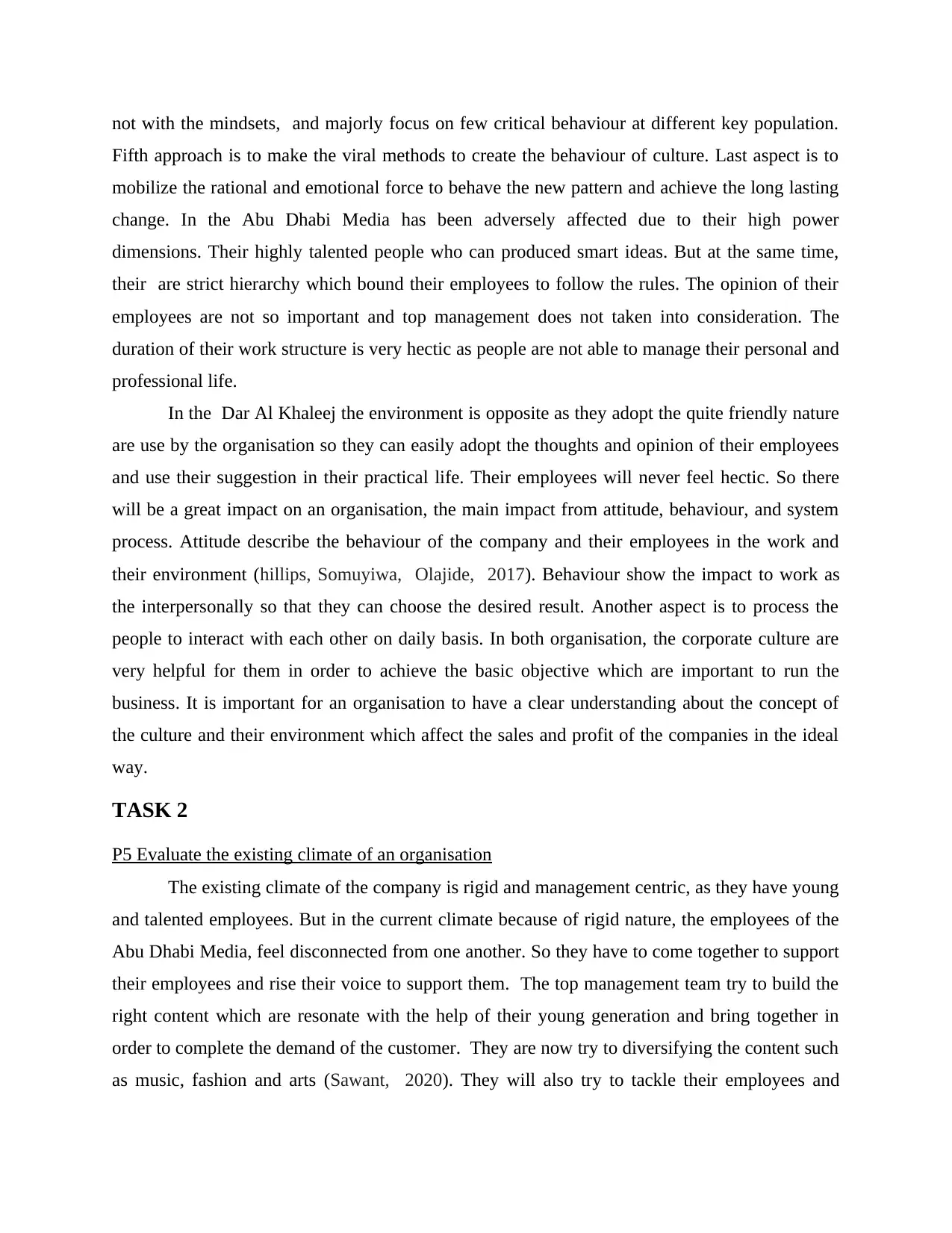
not with the mindsets, and majorly focus on few critical behaviour at different key population.
Fifth approach is to make the viral methods to create the behaviour of culture. Last aspect is to
mobilize the rational and emotional force to behave the new pattern and achieve the long lasting
change. In the Abu Dhabi Media has been adversely affected due to their high power
dimensions. Their highly talented people who can produced smart ideas. But at the same time,
their are strict hierarchy which bound their employees to follow the rules. The opinion of their
employees are not so important and top management does not taken into consideration. The
duration of their work structure is very hectic as people are not able to manage their personal and
professional life.
In the Dar Al Khaleej the environment is opposite as they adopt the quite friendly nature
are use by the organisation so they can easily adopt the thoughts and opinion of their employees
and use their suggestion in their practical life. Their employees will never feel hectic. So there
will be a great impact on an organisation, the main impact from attitude, behaviour, and system
process. Attitude describe the behaviour of the company and their employees in the work and
their environment (hillips, Somuyiwa, Olajide, 2017). Behaviour show the impact to work as
the interpersonally so that they can choose the desired result. Another aspect is to process the
people to interact with each other on daily basis. In both organisation, the corporate culture are
very helpful for them in order to achieve the basic objective which are important to run the
business. It is important for an organisation to have a clear understanding about the concept of
the culture and their environment which affect the sales and profit of the companies in the ideal
way.
TASK 2
P5 Evaluate the existing climate of an organisation
The existing climate of the company is rigid and management centric, as they have young
and talented employees. But in the current climate because of rigid nature, the employees of the
Abu Dhabi Media, feel disconnected from one another. So they have to come together to support
their employees and rise their voice to support them. The top management team try to build the
right content which are resonate with the help of their young generation and bring together in
order to complete the demand of the customer. They are now try to diversifying the content such
as music, fashion and arts (Sawant, 2020). They will also try to tackle their employees and
Fifth approach is to make the viral methods to create the behaviour of culture. Last aspect is to
mobilize the rational and emotional force to behave the new pattern and achieve the long lasting
change. In the Abu Dhabi Media has been adversely affected due to their high power
dimensions. Their highly talented people who can produced smart ideas. But at the same time,
their are strict hierarchy which bound their employees to follow the rules. The opinion of their
employees are not so important and top management does not taken into consideration. The
duration of their work structure is very hectic as people are not able to manage their personal and
professional life.
In the Dar Al Khaleej the environment is opposite as they adopt the quite friendly nature
are use by the organisation so they can easily adopt the thoughts and opinion of their employees
and use their suggestion in their practical life. Their employees will never feel hectic. So there
will be a great impact on an organisation, the main impact from attitude, behaviour, and system
process. Attitude describe the behaviour of the company and their employees in the work and
their environment (hillips, Somuyiwa, Olajide, 2017). Behaviour show the impact to work as
the interpersonally so that they can choose the desired result. Another aspect is to process the
people to interact with each other on daily basis. In both organisation, the corporate culture are
very helpful for them in order to achieve the basic objective which are important to run the
business. It is important for an organisation to have a clear understanding about the concept of
the culture and their environment which affect the sales and profit of the companies in the ideal
way.
TASK 2
P5 Evaluate the existing climate of an organisation
The existing climate of the company is rigid and management centric, as they have young
and talented employees. But in the current climate because of rigid nature, the employees of the
Abu Dhabi Media, feel disconnected from one another. So they have to come together to support
their employees and rise their voice to support them. The top management team try to build the
right content which are resonate with the help of their young generation and bring together in
order to complete the demand of the customer. They are now try to diversifying the content such
as music, fashion and arts (Sawant, 2020). They will also try to tackle their employees and
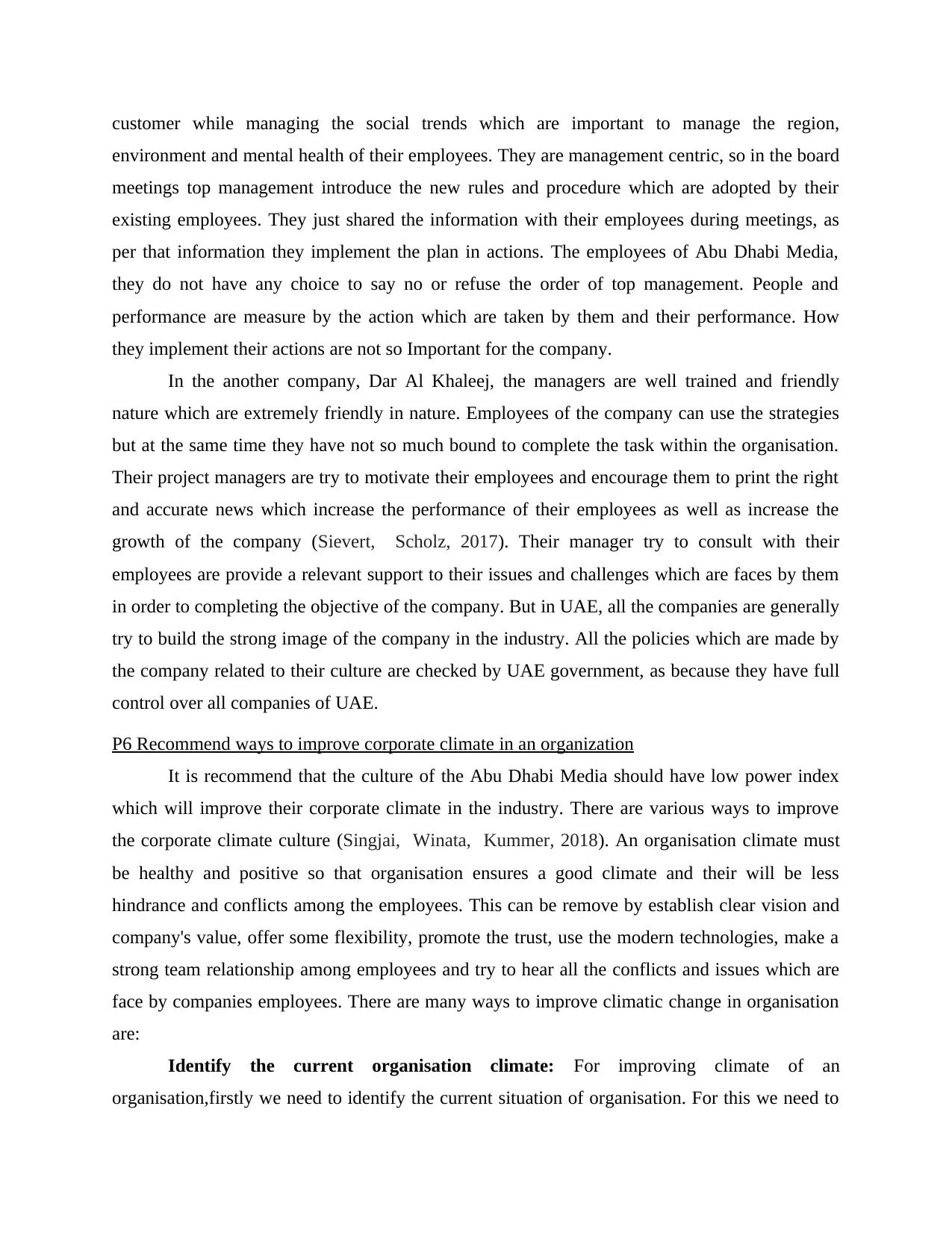
customer while managing the social trends which are important to manage the region,
environment and mental health of their employees. They are management centric, so in the board
meetings top management introduce the new rules and procedure which are adopted by their
existing employees. They just shared the information with their employees during meetings, as
per that information they implement the plan in actions. The employees of Abu Dhabi Media,
they do not have any choice to say no or refuse the order of top management. People and
performance are measure by the action which are taken by them and their performance. How
they implement their actions are not so Important for the company.
In the another company, Dar Al Khaleej, the managers are well trained and friendly
nature which are extremely friendly in nature. Employees of the company can use the strategies
but at the same time they have not so much bound to complete the task within the organisation.
Their project managers are try to motivate their employees and encourage them to print the right
and accurate news which increase the performance of their employees as well as increase the
growth of the company (Sievert, Scholz, 2017). Their manager try to consult with their
employees are provide a relevant support to their issues and challenges which are faces by them
in order to completing the objective of the company. But in UAE, all the companies are generally
try to build the strong image of the company in the industry. All the policies which are made by
the company related to their culture are checked by UAE government, as because they have full
control over all companies of UAE.
P6 Recommend ways to improve corporate climate in an organization
It is recommend that the culture of the Abu Dhabi Media should have low power index
which will improve their corporate climate in the industry. There are various ways to improve
the corporate climate culture (Singjai, Winata, Kummer, 2018). An organisation climate must
be healthy and positive so that organisation ensures a good climate and their will be less
hindrance and conflicts among the employees. This can be remove by establish clear vision and
company's value, offer some flexibility, promote the trust, use the modern technologies, make a
strong team relationship among employees and try to hear all the conflicts and issues which are
face by companies employees. There are many ways to improve climatic change in organisation
are:
Identify the current organisation climate: For improving climate of an
organisation,firstly we need to identify the current situation of organisation. For this we need to
environment and mental health of their employees. They are management centric, so in the board
meetings top management introduce the new rules and procedure which are adopted by their
existing employees. They just shared the information with their employees during meetings, as
per that information they implement the plan in actions. The employees of Abu Dhabi Media,
they do not have any choice to say no or refuse the order of top management. People and
performance are measure by the action which are taken by them and their performance. How
they implement their actions are not so Important for the company.
In the another company, Dar Al Khaleej, the managers are well trained and friendly
nature which are extremely friendly in nature. Employees of the company can use the strategies
but at the same time they have not so much bound to complete the task within the organisation.
Their project managers are try to motivate their employees and encourage them to print the right
and accurate news which increase the performance of their employees as well as increase the
growth of the company (Sievert, Scholz, 2017). Their manager try to consult with their
employees are provide a relevant support to their issues and challenges which are faces by them
in order to completing the objective of the company. But in UAE, all the companies are generally
try to build the strong image of the company in the industry. All the policies which are made by
the company related to their culture are checked by UAE government, as because they have full
control over all companies of UAE.
P6 Recommend ways to improve corporate climate in an organization
It is recommend that the culture of the Abu Dhabi Media should have low power index
which will improve their corporate climate in the industry. There are various ways to improve
the corporate climate culture (Singjai, Winata, Kummer, 2018). An organisation climate must
be healthy and positive so that organisation ensures a good climate and their will be less
hindrance and conflicts among the employees. This can be remove by establish clear vision and
company's value, offer some flexibility, promote the trust, use the modern technologies, make a
strong team relationship among employees and try to hear all the conflicts and issues which are
face by companies employees. There are many ways to improve climatic change in organisation
are:
Identify the current organisation climate: For improving climate of an
organisation,firstly we need to identify the current situation of organisation. For this we need to
Secure Best Marks with AI Grader
Need help grading? Try our AI Grader for instant feedback on your assignments.
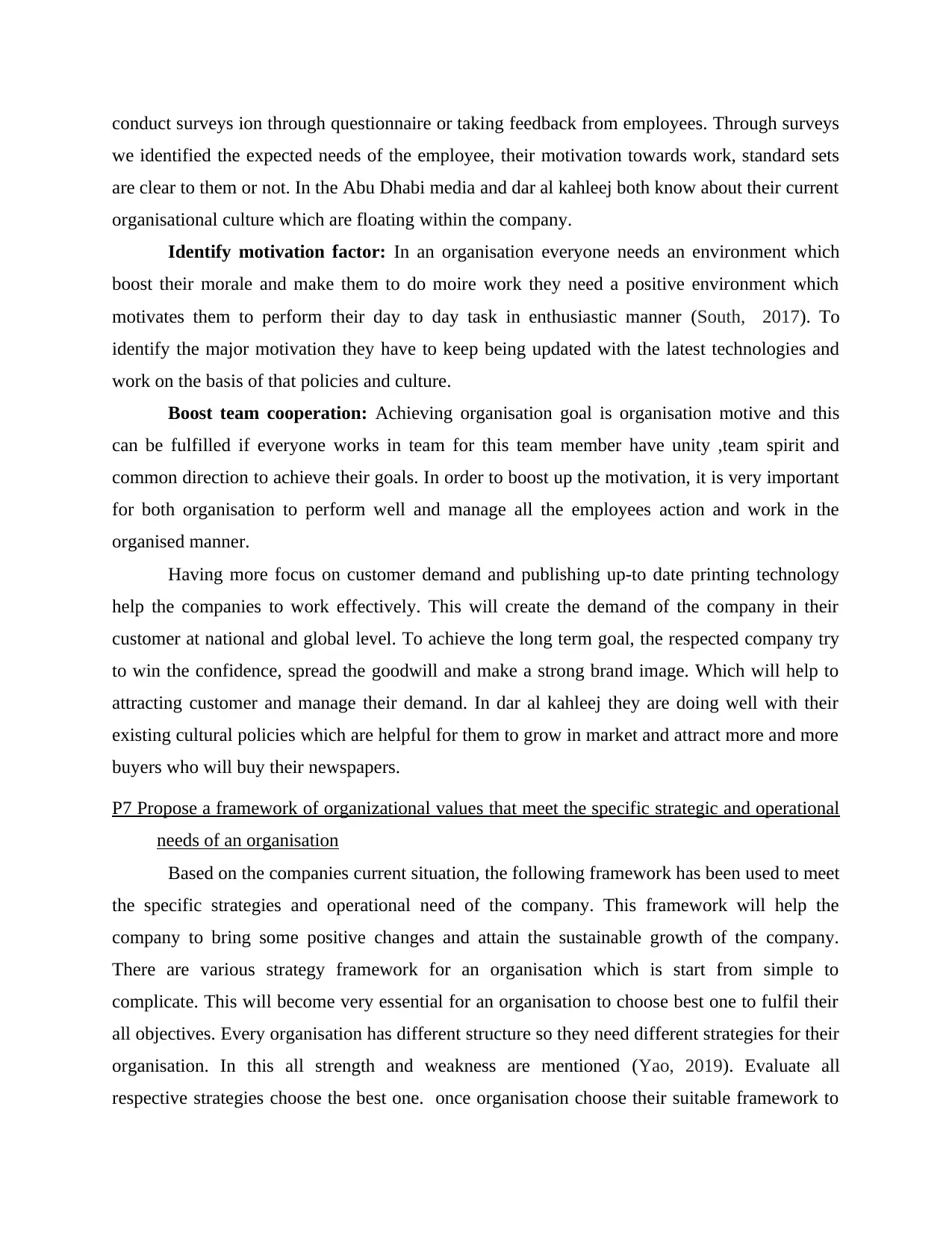
conduct surveys ion through questionnaire or taking feedback from employees. Through surveys
we identified the expected needs of the employee, their motivation towards work, standard sets
are clear to them or not. In the Abu Dhabi media and dar al kahleej both know about their current
organisational culture which are floating within the company.
Identify motivation factor: In an organisation everyone needs an environment which
boost their morale and make them to do moire work they need a positive environment which
motivates them to perform their day to day task in enthusiastic manner (South, 2017). To
identify the major motivation they have to keep being updated with the latest technologies and
work on the basis of that policies and culture.
Boost team cooperation: Achieving organisation goal is organisation motive and this
can be fulfilled if everyone works in team for this team member have unity ,team spirit and
common direction to achieve their goals. In order to boost up the motivation, it is very important
for both organisation to perform well and manage all the employees action and work in the
organised manner.
Having more focus on customer demand and publishing up-to date printing technology
help the companies to work effectively. This will create the demand of the company in their
customer at national and global level. To achieve the long term goal, the respected company try
to win the confidence, spread the goodwill and make a strong brand image. Which will help to
attracting customer and manage their demand. In dar al kahleej they are doing well with their
existing cultural policies which are helpful for them to grow in market and attract more and more
buyers who will buy their newspapers.
P7 Propose a framework of organizational values that meet the specific strategic and operational
needs of an organisation
Based on the companies current situation, the following framework has been used to meet
the specific strategies and operational need of the company. This framework will help the
company to bring some positive changes and attain the sustainable growth of the company.
There are various strategy framework for an organisation which is start from simple to
complicate. This will become very essential for an organisation to choose best one to fulfil their
all objectives. Every organisation has different structure so they need different strategies for their
organisation. In this all strength and weakness are mentioned (Yao, 2019). Evaluate all
respective strategies choose the best one. once organisation choose their suitable framework to
we identified the expected needs of the employee, their motivation towards work, standard sets
are clear to them or not. In the Abu Dhabi media and dar al kahleej both know about their current
organisational culture which are floating within the company.
Identify motivation factor: In an organisation everyone needs an environment which
boost their morale and make them to do moire work they need a positive environment which
motivates them to perform their day to day task in enthusiastic manner (South, 2017). To
identify the major motivation they have to keep being updated with the latest technologies and
work on the basis of that policies and culture.
Boost team cooperation: Achieving organisation goal is organisation motive and this
can be fulfilled if everyone works in team for this team member have unity ,team spirit and
common direction to achieve their goals. In order to boost up the motivation, it is very important
for both organisation to perform well and manage all the employees action and work in the
organised manner.
Having more focus on customer demand and publishing up-to date printing technology
help the companies to work effectively. This will create the demand of the company in their
customer at national and global level. To achieve the long term goal, the respected company try
to win the confidence, spread the goodwill and make a strong brand image. Which will help to
attracting customer and manage their demand. In dar al kahleej they are doing well with their
existing cultural policies which are helpful for them to grow in market and attract more and more
buyers who will buy their newspapers.
P7 Propose a framework of organizational values that meet the specific strategic and operational
needs of an organisation
Based on the companies current situation, the following framework has been used to meet
the specific strategies and operational need of the company. This framework will help the
company to bring some positive changes and attain the sustainable growth of the company.
There are various strategy framework for an organisation which is start from simple to
complicate. This will become very essential for an organisation to choose best one to fulfil their
all objectives. Every organisation has different structure so they need different strategies for their
organisation. In this all strength and weakness are mentioned (Yao, 2019). Evaluate all
respective strategies choose the best one. once organisation choose their suitable framework to
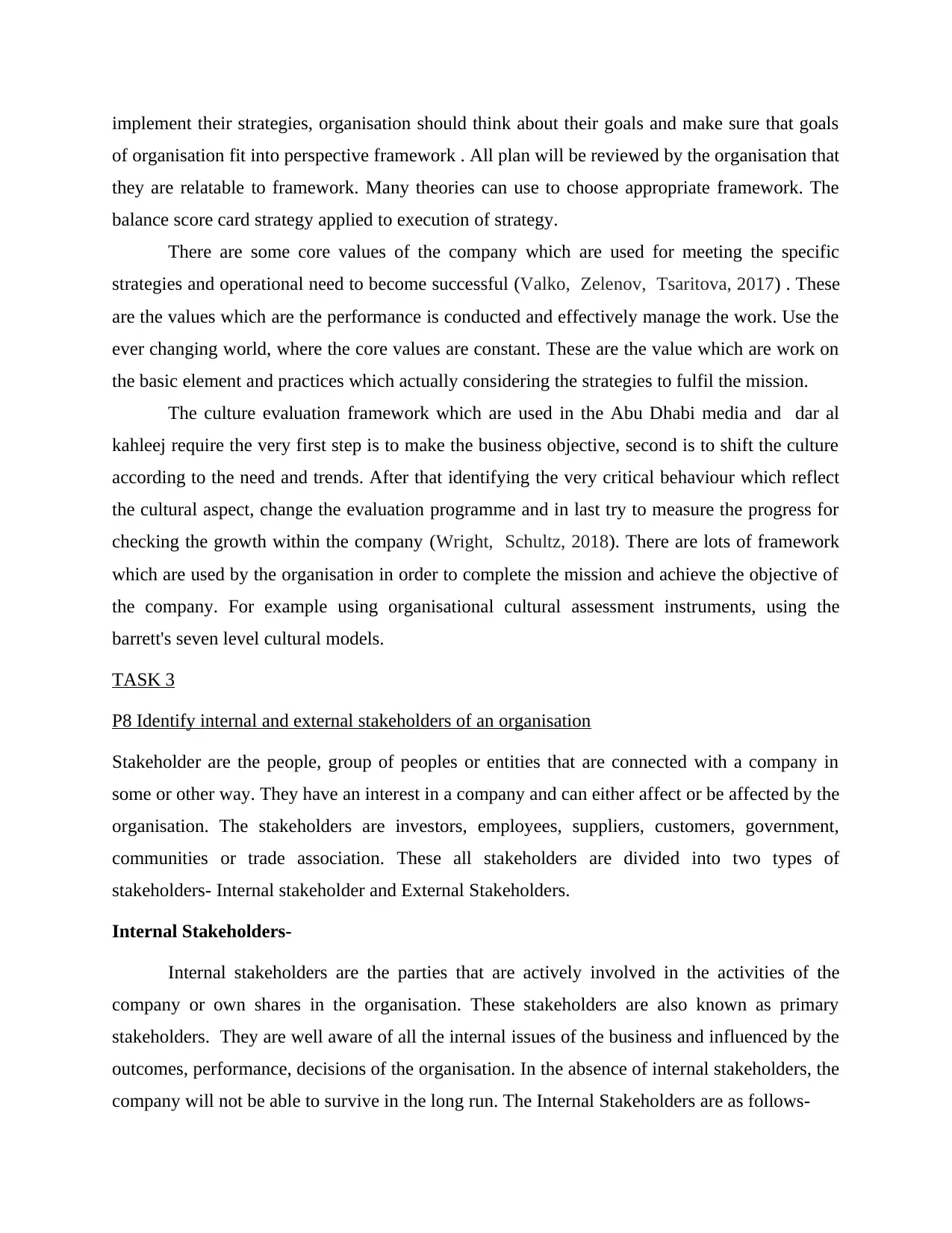
implement their strategies, organisation should think about their goals and make sure that goals
of organisation fit into perspective framework . All plan will be reviewed by the organisation that
they are relatable to framework. Many theories can use to choose appropriate framework. The
balance score card strategy applied to execution of strategy.
There are some core values of the company which are used for meeting the specific
strategies and operational need to become successful (Valko, Zelenov, Tsaritova, 2017) . These
are the values which are the performance is conducted and effectively manage the work. Use the
ever changing world, where the core values are constant. These are the value which are work on
the basic element and practices which actually considering the strategies to fulfil the mission.
The culture evaluation framework which are used in the Abu Dhabi media and dar al
kahleej require the very first step is to make the business objective, second is to shift the culture
according to the need and trends. After that identifying the very critical behaviour which reflect
the cultural aspect, change the evaluation programme and in last try to measure the progress for
checking the growth within the company (Wright, Schultz, 2018). There are lots of framework
which are used by the organisation in order to complete the mission and achieve the objective of
the company. For example using organisational cultural assessment instruments, using the
barrett's seven level cultural models.
TASK 3
P8 Identify internal and external stakeholders of an organisation
Stakeholder are the people, group of peoples or entities that are connected with a company in
some or other way. They have an interest in a company and can either affect or be affected by the
organisation. The stakeholders are investors, employees, suppliers, customers, government,
communities or trade association. These all stakeholders are divided into two types of
stakeholders- Internal stakeholder and External Stakeholders.
Internal Stakeholders-
Internal stakeholders are the parties that are actively involved in the activities of the
company or own shares in the organisation. These stakeholders are also known as primary
stakeholders. They are well aware of all the internal issues of the business and influenced by the
outcomes, performance, decisions of the organisation. In the absence of internal stakeholders, the
company will not be able to survive in the long run. The Internal Stakeholders are as follows-
of organisation fit into perspective framework . All plan will be reviewed by the organisation that
they are relatable to framework. Many theories can use to choose appropriate framework. The
balance score card strategy applied to execution of strategy.
There are some core values of the company which are used for meeting the specific
strategies and operational need to become successful (Valko, Zelenov, Tsaritova, 2017) . These
are the values which are the performance is conducted and effectively manage the work. Use the
ever changing world, where the core values are constant. These are the value which are work on
the basic element and practices which actually considering the strategies to fulfil the mission.
The culture evaluation framework which are used in the Abu Dhabi media and dar al
kahleej require the very first step is to make the business objective, second is to shift the culture
according to the need and trends. After that identifying the very critical behaviour which reflect
the cultural aspect, change the evaluation programme and in last try to measure the progress for
checking the growth within the company (Wright, Schultz, 2018). There are lots of framework
which are used by the organisation in order to complete the mission and achieve the objective of
the company. For example using organisational cultural assessment instruments, using the
barrett's seven level cultural models.
TASK 3
P8 Identify internal and external stakeholders of an organisation
Stakeholder are the people, group of peoples or entities that are connected with a company in
some or other way. They have an interest in a company and can either affect or be affected by the
organisation. The stakeholders are investors, employees, suppliers, customers, government,
communities or trade association. These all stakeholders are divided into two types of
stakeholders- Internal stakeholder and External Stakeholders.
Internal Stakeholders-
Internal stakeholders are the parties that are actively involved in the activities of the
company or own shares in the organisation. These stakeholders are also known as primary
stakeholders. They are well aware of all the internal issues of the business and influenced by the
outcomes, performance, decisions of the organisation. In the absence of internal stakeholders, the
company will not be able to survive in the long run. The Internal Stakeholders are as follows-
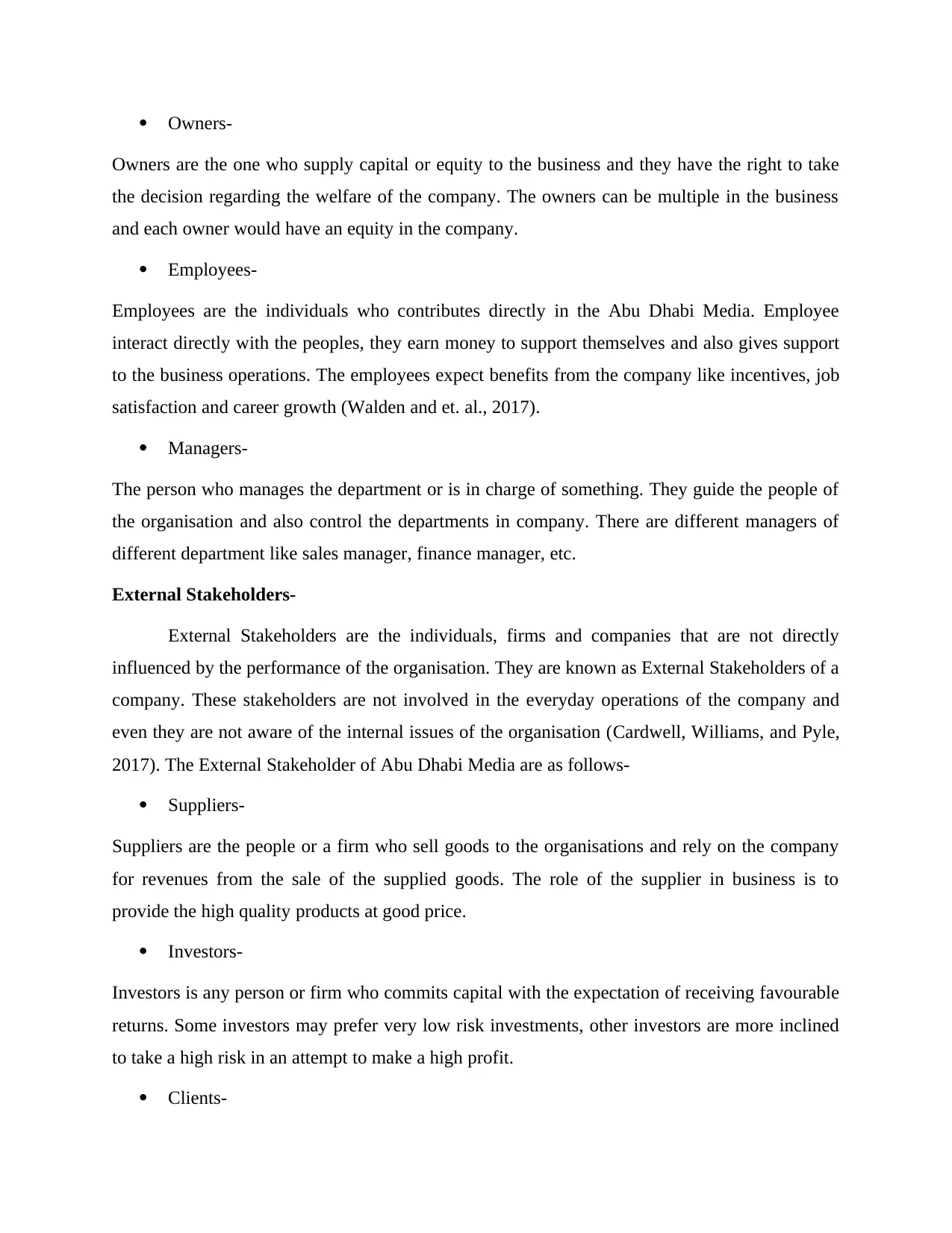
Owners-
Owners are the one who supply capital or equity to the business and they have the right to take
the decision regarding the welfare of the company. The owners can be multiple in the business
and each owner would have an equity in the company.
Employees-
Employees are the individuals who contributes directly in the Abu Dhabi Media. Employee
interact directly with the peoples, they earn money to support themselves and also gives support
to the business operations. The employees expect benefits from the company like incentives, job
satisfaction and career growth (Walden and et. al., 2017).
Managers-
The person who manages the department or is in charge of something. They guide the people of
the organisation and also control the departments in company. There are different managers of
different department like sales manager, finance manager, etc.
External Stakeholders-
External Stakeholders are the individuals, firms and companies that are not directly
influenced by the performance of the organisation. They are known as External Stakeholders of a
company. These stakeholders are not involved in the everyday operations of the company and
even they are not aware of the internal issues of the organisation (Cardwell, Williams, and Pyle,
2017). The External Stakeholder of Abu Dhabi Media are as follows-
Suppliers-
Suppliers are the people or a firm who sell goods to the organisations and rely on the company
for revenues from the sale of the supplied goods. The role of the supplier in business is to
provide the high quality products at good price.
Investors-
Investors is any person or firm who commits capital with the expectation of receiving favourable
returns. Some investors may prefer very low risk investments, other investors are more inclined
to take a high risk in an attempt to make a high profit.
Clients-
Owners are the one who supply capital or equity to the business and they have the right to take
the decision regarding the welfare of the company. The owners can be multiple in the business
and each owner would have an equity in the company.
Employees-
Employees are the individuals who contributes directly in the Abu Dhabi Media. Employee
interact directly with the peoples, they earn money to support themselves and also gives support
to the business operations. The employees expect benefits from the company like incentives, job
satisfaction and career growth (Walden and et. al., 2017).
Managers-
The person who manages the department or is in charge of something. They guide the people of
the organisation and also control the departments in company. There are different managers of
different department like sales manager, finance manager, etc.
External Stakeholders-
External Stakeholders are the individuals, firms and companies that are not directly
influenced by the performance of the organisation. They are known as External Stakeholders of a
company. These stakeholders are not involved in the everyday operations of the company and
even they are not aware of the internal issues of the organisation (Cardwell, Williams, and Pyle,
2017). The External Stakeholder of Abu Dhabi Media are as follows-
Suppliers-
Suppliers are the people or a firm who sell goods to the organisations and rely on the company
for revenues from the sale of the supplied goods. The role of the supplier in business is to
provide the high quality products at good price.
Investors-
Investors is any person or firm who commits capital with the expectation of receiving favourable
returns. Some investors may prefer very low risk investments, other investors are more inclined
to take a high risk in an attempt to make a high profit.
Clients-
Paraphrase This Document
Need a fresh take? Get an instant paraphrase of this document with our AI Paraphraser
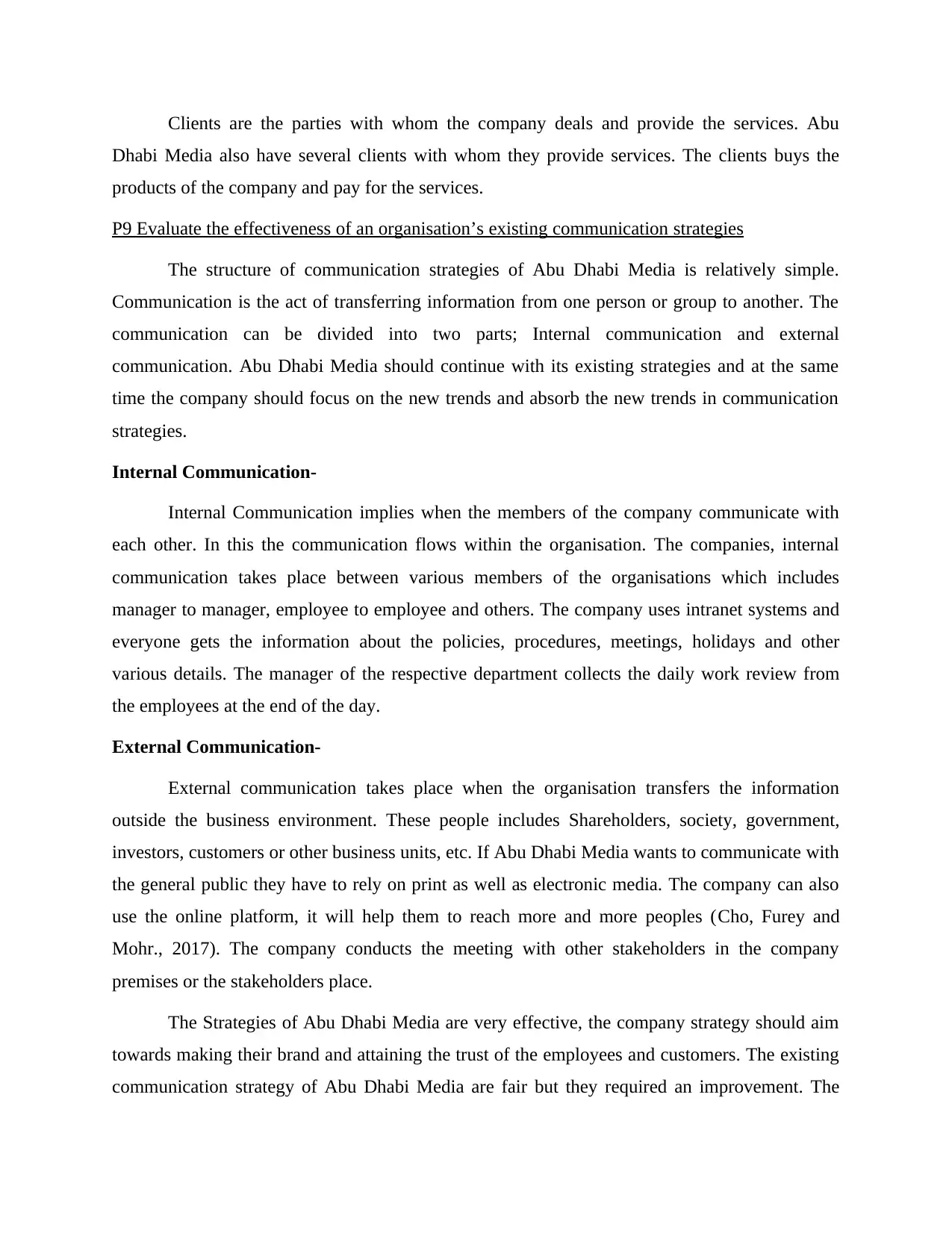
Clients are the parties with whom the company deals and provide the services. Abu
Dhabi Media also have several clients with whom they provide services. The clients buys the
products of the company and pay for the services.
P9 Evaluate the effectiveness of an organisation’s existing communication strategies
The structure of communication strategies of Abu Dhabi Media is relatively simple.
Communication is the act of transferring information from one person or group to another. The
communication can be divided into two parts; Internal communication and external
communication. Abu Dhabi Media should continue with its existing strategies and at the same
time the company should focus on the new trends and absorb the new trends in communication
strategies.
Internal Communication-
Internal Communication implies when the members of the company communicate with
each other. In this the communication flows within the organisation. The companies, internal
communication takes place between various members of the organisations which includes
manager to manager, employee to employee and others. The company uses intranet systems and
everyone gets the information about the policies, procedures, meetings, holidays and other
various details. The manager of the respective department collects the daily work review from
the employees at the end of the day.
External Communication-
External communication takes place when the organisation transfers the information
outside the business environment. These people includes Shareholders, society, government,
investors, customers or other business units, etc. If Abu Dhabi Media wants to communicate with
the general public they have to rely on print as well as electronic media. The company can also
use the online platform, it will help them to reach more and more peoples (Cho, Furey and
Mohr., 2017). The company conducts the meeting with other stakeholders in the company
premises or the stakeholders place.
The Strategies of Abu Dhabi Media are very effective, the company strategy should aim
towards making their brand and attaining the trust of the employees and customers. The existing
communication strategy of Abu Dhabi Media are fair but they required an improvement. The
Dhabi Media also have several clients with whom they provide services. The clients buys the
products of the company and pay for the services.
P9 Evaluate the effectiveness of an organisation’s existing communication strategies
The structure of communication strategies of Abu Dhabi Media is relatively simple.
Communication is the act of transferring information from one person or group to another. The
communication can be divided into two parts; Internal communication and external
communication. Abu Dhabi Media should continue with its existing strategies and at the same
time the company should focus on the new trends and absorb the new trends in communication
strategies.
Internal Communication-
Internal Communication implies when the members of the company communicate with
each other. In this the communication flows within the organisation. The companies, internal
communication takes place between various members of the organisations which includes
manager to manager, employee to employee and others. The company uses intranet systems and
everyone gets the information about the policies, procedures, meetings, holidays and other
various details. The manager of the respective department collects the daily work review from
the employees at the end of the day.
External Communication-
External communication takes place when the organisation transfers the information
outside the business environment. These people includes Shareholders, society, government,
investors, customers or other business units, etc. If Abu Dhabi Media wants to communicate with
the general public they have to rely on print as well as electronic media. The company can also
use the online platform, it will help them to reach more and more peoples (Cho, Furey and
Mohr., 2017). The company conducts the meeting with other stakeholders in the company
premises or the stakeholders place.
The Strategies of Abu Dhabi Media are very effective, the company strategy should aim
towards making their brand and attaining the trust of the employees and customers. The existing
communication strategy of Abu Dhabi Media are fair but they required an improvement. The
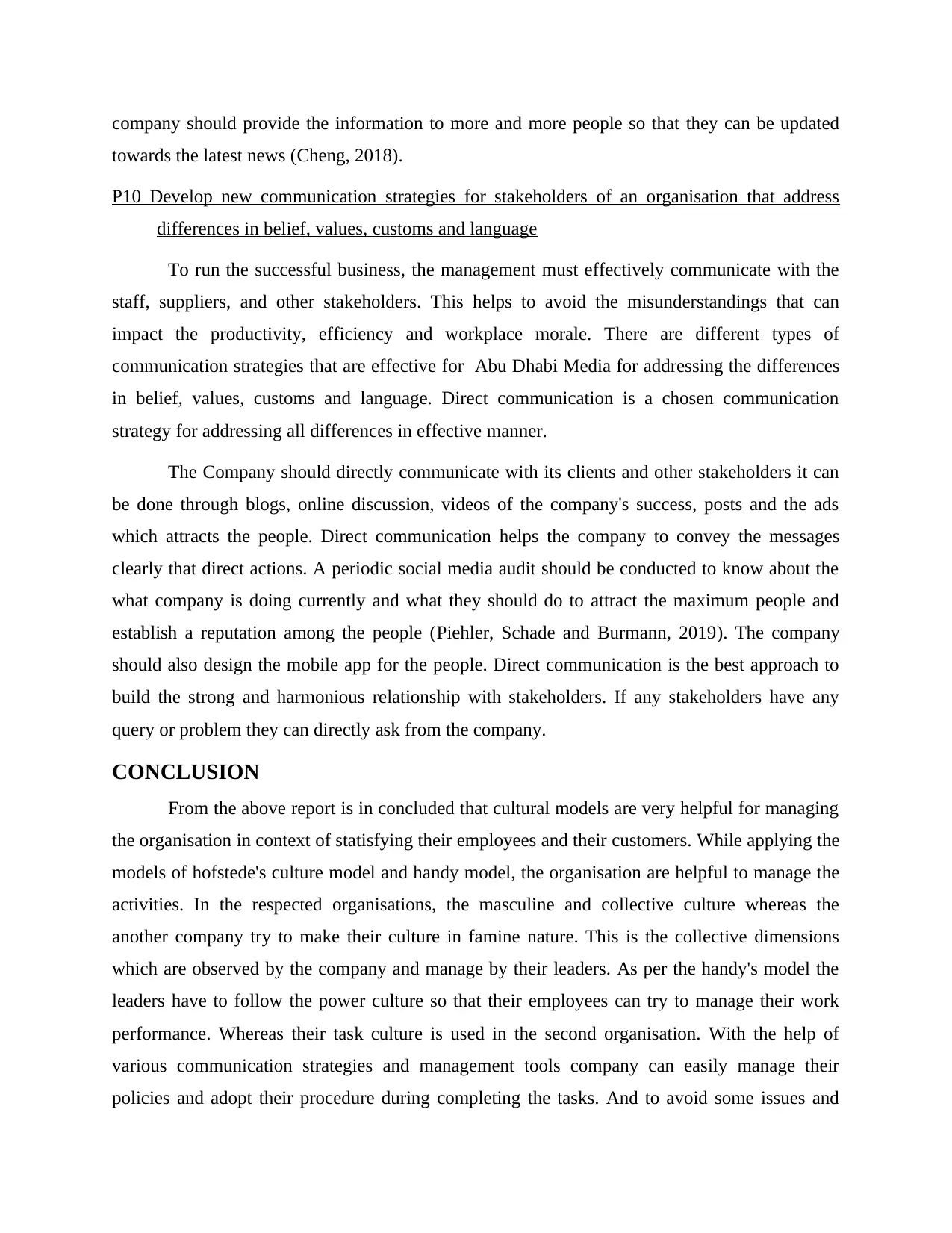
company should provide the information to more and more people so that they can be updated
towards the latest news (Cheng, 2018).
P10 Develop new communication strategies for stakeholders of an organisation that address
differences in belief, values, customs and language
To run the successful business, the management must effectively communicate with the
staff, suppliers, and other stakeholders. This helps to avoid the misunderstandings that can
impact the productivity, efficiency and workplace morale. There are different types of
communication strategies that are effective for Abu Dhabi Media for addressing the differences
in belief, values, customs and language. Direct communication is a chosen communication
strategy for addressing all differences in effective manner.
The Company should directly communicate with its clients and other stakeholders it can
be done through blogs, online discussion, videos of the company's success, posts and the ads
which attracts the people. Direct communication helps the company to convey the messages
clearly that direct actions. A periodic social media audit should be conducted to know about the
what company is doing currently and what they should do to attract the maximum people and
establish a reputation among the people (Piehler, Schade and Burmann, 2019). The company
should also design the mobile app for the people. Direct communication is the best approach to
build the strong and harmonious relationship with stakeholders. If any stakeholders have any
query or problem they can directly ask from the company.
CONCLUSION
From the above report is in concluded that cultural models are very helpful for managing
the organisation in context of statisfying their employees and their customers. While applying the
models of hofstede's culture model and handy model, the organisation are helpful to manage the
activities. In the respected organisations, the masculine and collective culture whereas the
another company try to make their culture in famine nature. This is the collective dimensions
which are observed by the company and manage by their leaders. As per the handy's model the
leaders have to follow the power culture so that their employees can try to manage their work
performance. Whereas their task culture is used in the second organisation. With the help of
various communication strategies and management tools company can easily manage their
policies and adopt their procedure during completing the tasks. And to avoid some issues and
towards the latest news (Cheng, 2018).
P10 Develop new communication strategies for stakeholders of an organisation that address
differences in belief, values, customs and language
To run the successful business, the management must effectively communicate with the
staff, suppliers, and other stakeholders. This helps to avoid the misunderstandings that can
impact the productivity, efficiency and workplace morale. There are different types of
communication strategies that are effective for Abu Dhabi Media for addressing the differences
in belief, values, customs and language. Direct communication is a chosen communication
strategy for addressing all differences in effective manner.
The Company should directly communicate with its clients and other stakeholders it can
be done through blogs, online discussion, videos of the company's success, posts and the ads
which attracts the people. Direct communication helps the company to convey the messages
clearly that direct actions. A periodic social media audit should be conducted to know about the
what company is doing currently and what they should do to attract the maximum people and
establish a reputation among the people (Piehler, Schade and Burmann, 2019). The company
should also design the mobile app for the people. Direct communication is the best approach to
build the strong and harmonious relationship with stakeholders. If any stakeholders have any
query or problem they can directly ask from the company.
CONCLUSION
From the above report is in concluded that cultural models are very helpful for managing
the organisation in context of statisfying their employees and their customers. While applying the
models of hofstede's culture model and handy model, the organisation are helpful to manage the
activities. In the respected organisations, the masculine and collective culture whereas the
another company try to make their culture in famine nature. This is the collective dimensions
which are observed by the company and manage by their leaders. As per the handy's model the
leaders have to follow the power culture so that their employees can try to manage their work
performance. Whereas their task culture is used in the second organisation. With the help of
various communication strategies and management tools company can easily manage their
policies and adopt their procedure during completing the tasks. And to avoid some issues and
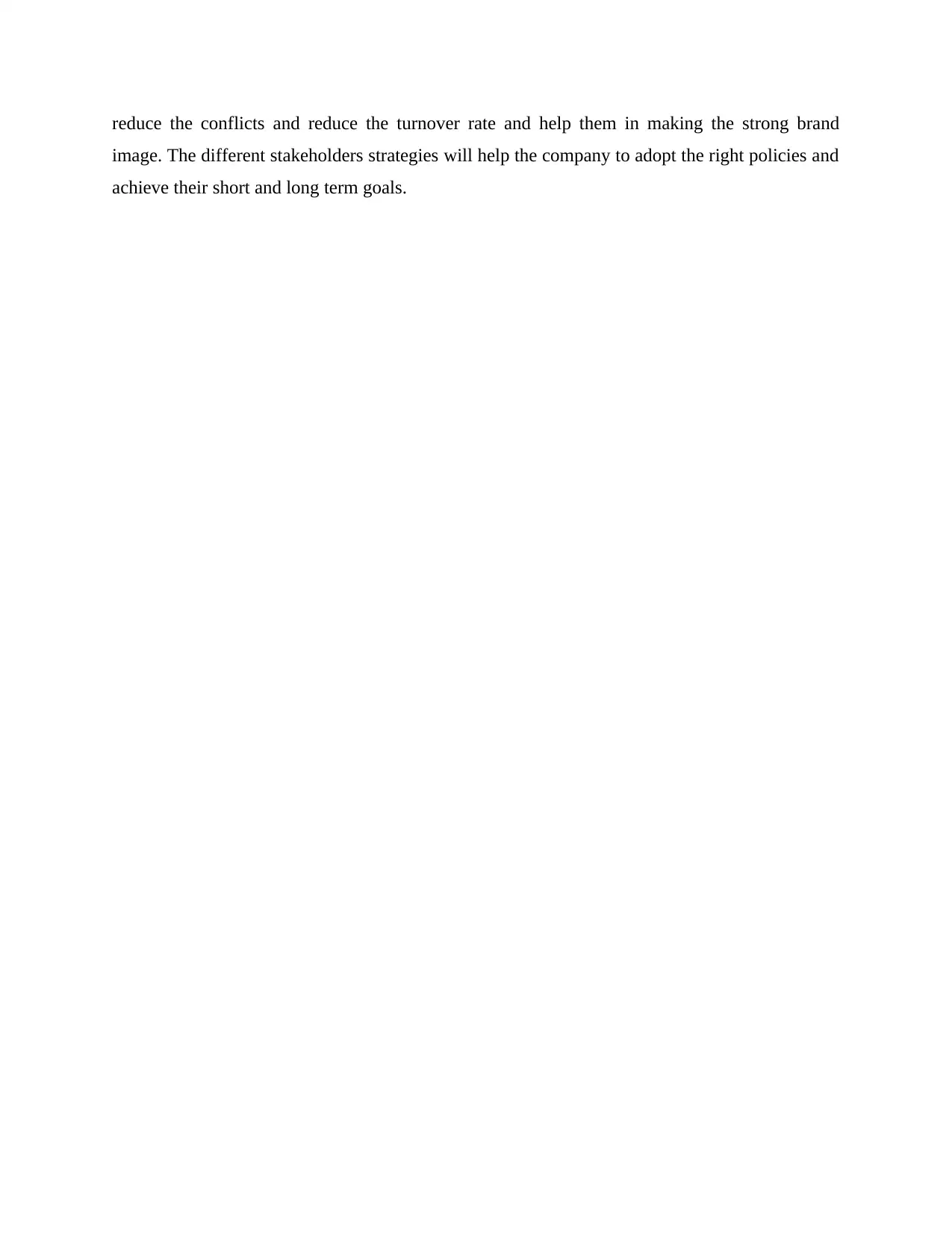
reduce the conflicts and reduce the turnover rate and help them in making the strong brand
image. The different stakeholders strategies will help the company to adopt the right policies and
achieve their short and long term goals.
image. The different stakeholders strategies will help the company to adopt the right policies and
achieve their short and long term goals.
Secure Best Marks with AI Grader
Need help grading? Try our AI Grader for instant feedback on your assignments.
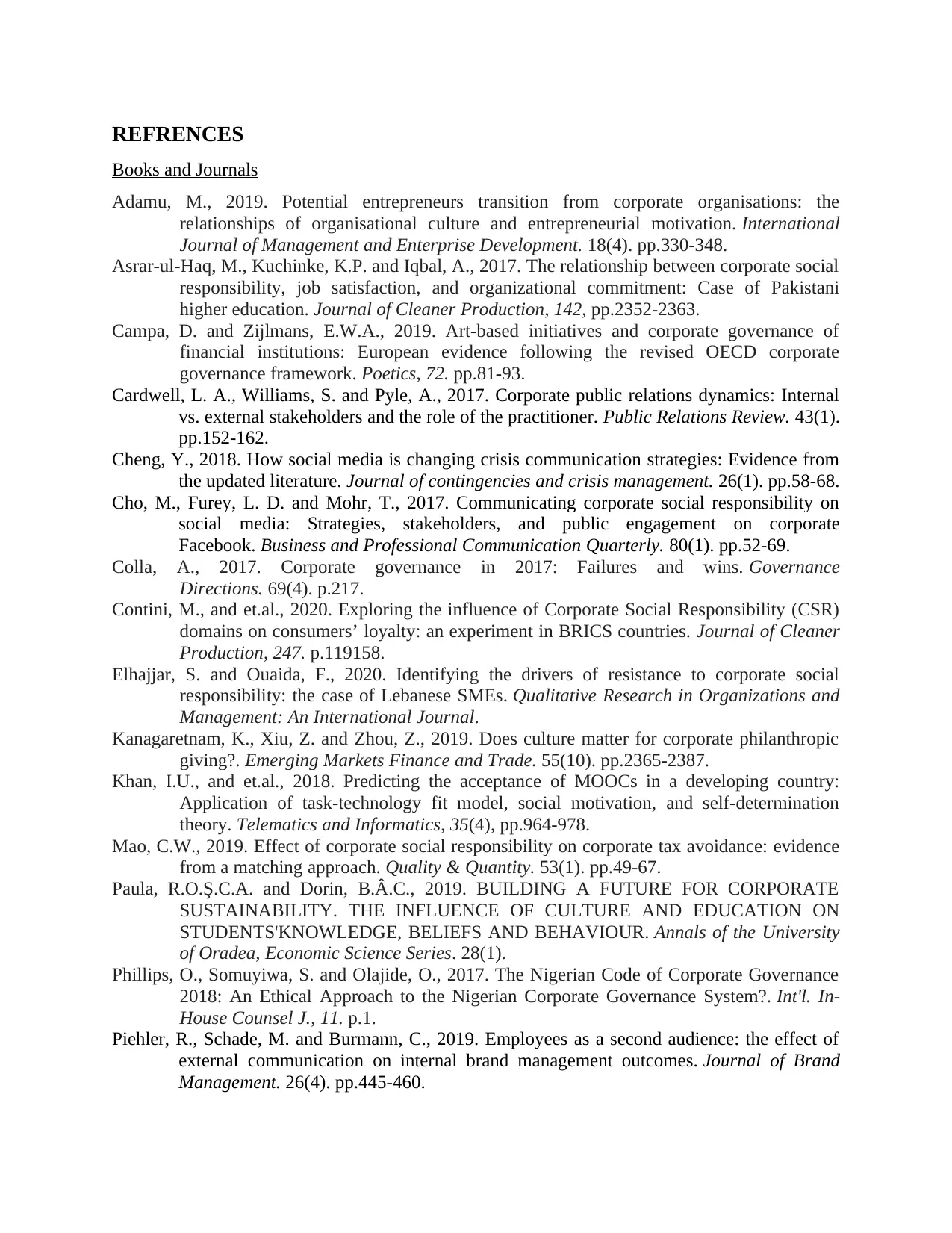
REFRENCES
Books and Journals
Adamu, M., 2019. Potential entrepreneurs transition from corporate organisations: the
relationships of organisational culture and entrepreneurial motivation. International
Journal of Management and Enterprise Development. 18(4). pp.330-348.
Asrar-ul-Haq, M., Kuchinke, K.P. and Iqbal, A., 2017. The relationship between corporate social
responsibility, job satisfaction, and organizational commitment: Case of Pakistani
higher education. Journal of Cleaner Production, 142, pp.2352-2363.
Campa, D. and Zijlmans, E.W.A., 2019. Art-based initiatives and corporate governance of
financial institutions: European evidence following the revised OECD corporate
governance framework. Poetics, 72. pp.81-93.
Cardwell, L. A., Williams, S. and Pyle, A., 2017. Corporate public relations dynamics: Internal
vs. external stakeholders and the role of the practitioner. Public Relations Review. 43(1).
pp.152-162.
Cheng, Y., 2018. How social media is changing crisis communication strategies: Evidence from
the updated literature. Journal of contingencies and crisis management. 26(1). pp.58-68.
Cho, M., Furey, L. D. and Mohr, T., 2017. Communicating corporate social responsibility on
social media: Strategies, stakeholders, and public engagement on corporate
Facebook. Business and Professional Communication Quarterly. 80(1). pp.52-69.
Colla, A., 2017. Corporate governance in 2017: Failures and wins. Governance
Directions. 69(4). p.217.
Contini, M., and et.al., 2020. Exploring the influence of Corporate Social Responsibility (CSR)
domains on consumers’ loyalty: an experiment in BRICS countries. Journal of Cleaner
Production, 247. p.119158.
Elhajjar, S. and Ouaida, F., 2020. Identifying the drivers of resistance to corporate social
responsibility: the case of Lebanese SMEs. Qualitative Research in Organizations and
Management: An International Journal.
Kanagaretnam, K., Xiu, Z. and Zhou, Z., 2019. Does culture matter for corporate philanthropic
giving?. Emerging Markets Finance and Trade. 55(10). pp.2365-2387.
Khan, I.U., and et.al., 2018. Predicting the acceptance of MOOCs in a developing country:
Application of task-technology fit model, social motivation, and self-determination
theory. Telematics and Informatics, 35(4), pp.964-978.
Mao, C.W., 2019. Effect of corporate social responsibility on corporate tax avoidance: evidence
from a matching approach. Quality & Quantity. 53(1). pp.49-67.
Paula, R.O.Ş.C.A. and Dorin, B.Â.C., 2019. BUILDING A FUTURE FOR CORPORATE
SUSTAINABILITY. THE INFLUENCE OF CULTURE AND EDUCATION ON
STUDENTS'KNOWLEDGE, BELIEFS AND BEHAVIOUR. Annals of the University
of Oradea, Economic Science Series. 28(1).
Phillips, O., Somuyiwa, S. and Olajide, O., 2017. The Nigerian Code of Corporate Governance
2018: An Ethical Approach to the Nigerian Corporate Governance System?. Int'l. In-
House Counsel J., 11. p.1.
Piehler, R., Schade, M. and Burmann, C., 2019. Employees as a second audience: the effect of
external communication on internal brand management outcomes. Journal of Brand
Management. 26(4). pp.445-460.
Books and Journals
Adamu, M., 2019. Potential entrepreneurs transition from corporate organisations: the
relationships of organisational culture and entrepreneurial motivation. International
Journal of Management and Enterprise Development. 18(4). pp.330-348.
Asrar-ul-Haq, M., Kuchinke, K.P. and Iqbal, A., 2017. The relationship between corporate social
responsibility, job satisfaction, and organizational commitment: Case of Pakistani
higher education. Journal of Cleaner Production, 142, pp.2352-2363.
Campa, D. and Zijlmans, E.W.A., 2019. Art-based initiatives and corporate governance of
financial institutions: European evidence following the revised OECD corporate
governance framework. Poetics, 72. pp.81-93.
Cardwell, L. A., Williams, S. and Pyle, A., 2017. Corporate public relations dynamics: Internal
vs. external stakeholders and the role of the practitioner. Public Relations Review. 43(1).
pp.152-162.
Cheng, Y., 2018. How social media is changing crisis communication strategies: Evidence from
the updated literature. Journal of contingencies and crisis management. 26(1). pp.58-68.
Cho, M., Furey, L. D. and Mohr, T., 2017. Communicating corporate social responsibility on
social media: Strategies, stakeholders, and public engagement on corporate
Facebook. Business and Professional Communication Quarterly. 80(1). pp.52-69.
Colla, A., 2017. Corporate governance in 2017: Failures and wins. Governance
Directions. 69(4). p.217.
Contini, M., and et.al., 2020. Exploring the influence of Corporate Social Responsibility (CSR)
domains on consumers’ loyalty: an experiment in BRICS countries. Journal of Cleaner
Production, 247. p.119158.
Elhajjar, S. and Ouaida, F., 2020. Identifying the drivers of resistance to corporate social
responsibility: the case of Lebanese SMEs. Qualitative Research in Organizations and
Management: An International Journal.
Kanagaretnam, K., Xiu, Z. and Zhou, Z., 2019. Does culture matter for corporate philanthropic
giving?. Emerging Markets Finance and Trade. 55(10). pp.2365-2387.
Khan, I.U., and et.al., 2018. Predicting the acceptance of MOOCs in a developing country:
Application of task-technology fit model, social motivation, and self-determination
theory. Telematics and Informatics, 35(4), pp.964-978.
Mao, C.W., 2019. Effect of corporate social responsibility on corporate tax avoidance: evidence
from a matching approach. Quality & Quantity. 53(1). pp.49-67.
Paula, R.O.Ş.C.A. and Dorin, B.Â.C., 2019. BUILDING A FUTURE FOR CORPORATE
SUSTAINABILITY. THE INFLUENCE OF CULTURE AND EDUCATION ON
STUDENTS'KNOWLEDGE, BELIEFS AND BEHAVIOUR. Annals of the University
of Oradea, Economic Science Series. 28(1).
Phillips, O., Somuyiwa, S. and Olajide, O., 2017. The Nigerian Code of Corporate Governance
2018: An Ethical Approach to the Nigerian Corporate Governance System?. Int'l. In-
House Counsel J., 11. p.1.
Piehler, R., Schade, M. and Burmann, C., 2019. Employees as a second audience: the effect of
external communication on internal brand management outcomes. Journal of Brand
Management. 26(4). pp.445-460.
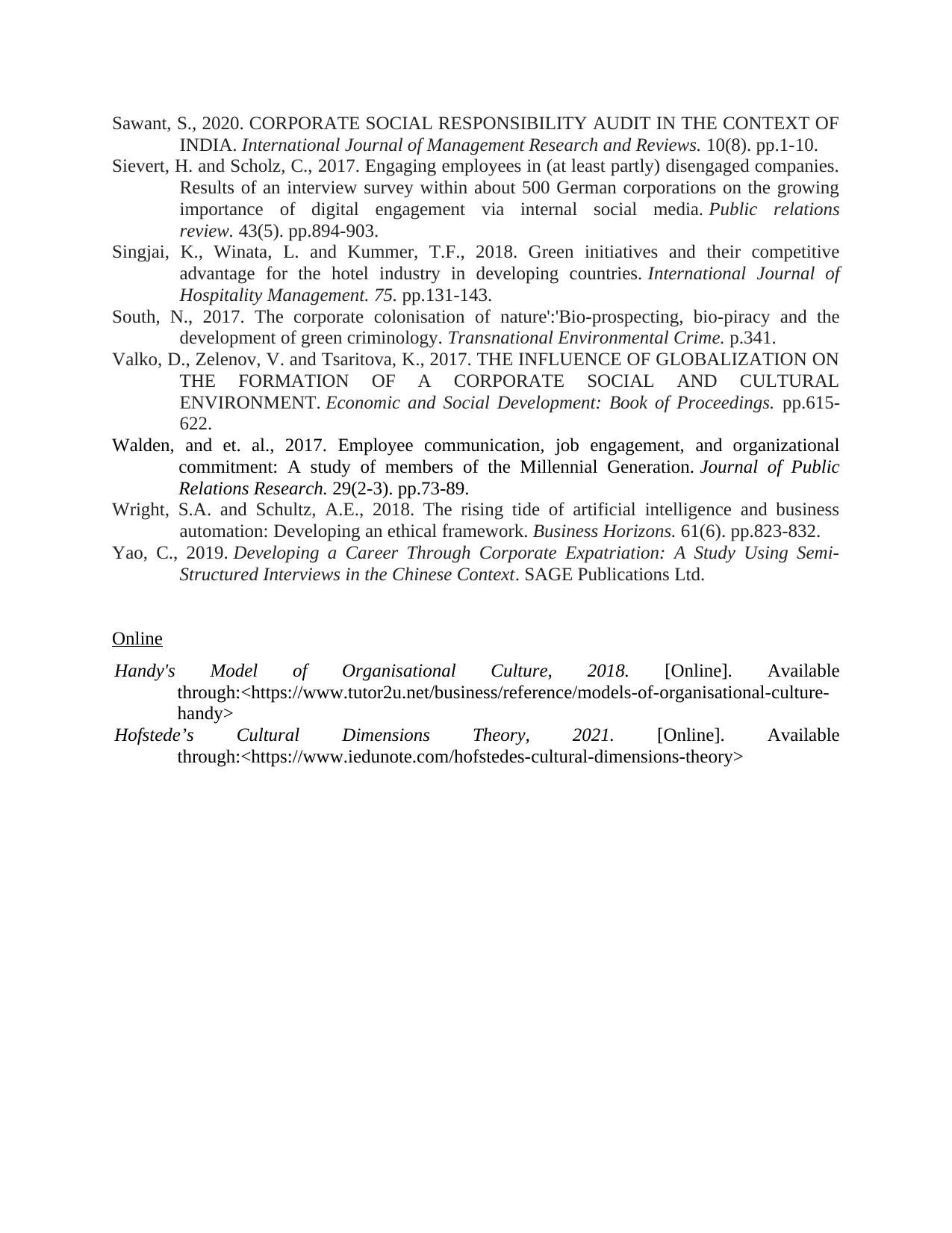
Sawant, S., 2020. CORPORATE SOCIAL RESPONSIBILITY AUDIT IN THE CONTEXT OF
INDIA. International Journal of Management Research and Reviews. 10(8). pp.1-10.
Sievert, H. and Scholz, C., 2017. Engaging employees in (at least partly) disengaged companies.
Results of an interview survey within about 500 German corporations on the growing
importance of digital engagement via internal social media. Public relations
review. 43(5). pp.894-903.
Singjai, K., Winata, L. and Kummer, T.F., 2018. Green initiatives and their competitive
advantage for the hotel industry in developing countries. International Journal of
Hospitality Management. 75. pp.131-143.
South, N., 2017. The corporate colonisation of nature':'Bio-prospecting, bio-piracy and the
development of green criminology. Transnational Environmental Crime. p.341.
Valko, D., Zelenov, V. and Tsaritova, K., 2017. THE INFLUENCE OF GLOBALIZATION ON
THE FORMATION OF A CORPORATE SOCIAL AND CULTURAL
ENVIRONMENT. Economic and Social Development: Book of Proceedings. pp.615-
622.
Walden, and et. al., 2017. Employee communication, job engagement, and organizational
commitment: A study of members of the Millennial Generation. Journal of Public
Relations Research. 29(2-3). pp.73-89.
Wright, S.A. and Schultz, A.E., 2018. The rising tide of artificial intelligence and business
automation: Developing an ethical framework. Business Horizons. 61(6). pp.823-832.
Yao, C., 2019. Developing a Career Through Corporate Expatriation: A Study Using Semi-
Structured Interviews in the Chinese Context. SAGE Publications Ltd.
Online
Handy's Model of Organisational Culture, 2018. [Online]. Available
through:<https://www.tutor2u.net/business/reference/models-of-organisational-culture-
handy>
Hofstede’s Cultural Dimensions Theory, 2021. [Online]. Available
through:<https://www.iedunote.com/hofstedes-cultural-dimensions-theory>
INDIA. International Journal of Management Research and Reviews. 10(8). pp.1-10.
Sievert, H. and Scholz, C., 2017. Engaging employees in (at least partly) disengaged companies.
Results of an interview survey within about 500 German corporations on the growing
importance of digital engagement via internal social media. Public relations
review. 43(5). pp.894-903.
Singjai, K., Winata, L. and Kummer, T.F., 2018. Green initiatives and their competitive
advantage for the hotel industry in developing countries. International Journal of
Hospitality Management. 75. pp.131-143.
South, N., 2017. The corporate colonisation of nature':'Bio-prospecting, bio-piracy and the
development of green criminology. Transnational Environmental Crime. p.341.
Valko, D., Zelenov, V. and Tsaritova, K., 2017. THE INFLUENCE OF GLOBALIZATION ON
THE FORMATION OF A CORPORATE SOCIAL AND CULTURAL
ENVIRONMENT. Economic and Social Development: Book of Proceedings. pp.615-
622.
Walden, and et. al., 2017. Employee communication, job engagement, and organizational
commitment: A study of members of the Millennial Generation. Journal of Public
Relations Research. 29(2-3). pp.73-89.
Wright, S.A. and Schultz, A.E., 2018. The rising tide of artificial intelligence and business
automation: Developing an ethical framework. Business Horizons. 61(6). pp.823-832.
Yao, C., 2019. Developing a Career Through Corporate Expatriation: A Study Using Semi-
Structured Interviews in the Chinese Context. SAGE Publications Ltd.
Online
Handy's Model of Organisational Culture, 2018. [Online]. Available
through:<https://www.tutor2u.net/business/reference/models-of-organisational-culture-
handy>
Hofstede’s Cultural Dimensions Theory, 2021. [Online]. Available
through:<https://www.iedunote.com/hofstedes-cultural-dimensions-theory>
1 out of 18
Related Documents
Your All-in-One AI-Powered Toolkit for Academic Success.
+13062052269
info@desklib.com
Available 24*7 on WhatsApp / Email
![[object Object]](/_next/static/media/star-bottom.7253800d.svg)
Unlock your academic potential
© 2024 | Zucol Services PVT LTD | All rights reserved.





